2024 Trek Slash Review | Is this high pivot enduro bike fashionably late, or just late to the party?
The not-so-minor details, 2024 trek slash 9.8 gx axs.
https://www.trekbikes.com
From $6,999 AUD ($10,499 AUD as tested)
- Incredible composure on the rowdiest terrain - Plush & well-controlled suspension - Surprisingly efficient pedalling performance - Mullet setup injects welcome agility - Loads of in-built adjustability
- Extra pulleys add complexity & noise - Tyres too flimsy for the application - Downtube storage is on the small side - Chainstay armour lacks damping - GX derailleur clutch failure

Dan reviews the 2024 Trek Slash
The Trek Slash has undoubtedly been one of the most popular enduro bikes on the market since it was first introduced back in 2011. It was late 2020 when we tested the last version, which impressed us with its buttery-smooth suspension performance and surprising agility for what was a big and burly brawler.
For 2024 however, the Slash has been completely redesigned from the ground-up. Featuring a high pivot suspension design, additional pulley wheels and a mullet setup, it is quite clearly a very different bike to its predecessor.
So how do all the changes play out on the trail? And what about those online reports of chain-dropping issues? We’ll be discussing all of that, and more, in our in-depth review of the new 2024 Trek Slash.
Watch our video review of the 2024 Trek Slash:

It eats up square edge hits for breakfast, while the neutral anti-squat and ABP platform means the back end is unencumbered by drivetrain and braking forces.

An overview of the 2024 Trek Slash
Built for enduro racing and bikepark thrashing, the Trek Slash is designed to compete with the likes of the Merida One-Sixty , Giant Reign and Canyon Strive .
Featuring an all-new frame for 2024, the Slash is now equipped with 170mm of travel front and rear. It comes set up from the factory as a mullet, though by fitting a different shock mount it’s possible to run a 29in rear wheel. The exception is the Small frame size that is purpose-built around 27.5in wheels front and rear.

You’ll still find a four-bar ABP platform, with the most rearward pivot located around the rear axle to help isolate brake forces from the suspension. Trek’s engineers have moved the main pivot almost halfway up the seat tube, which creates a more pronounced rearward axle path. To mitigate chain growth, a large 19T idler wheel routes the chain close to the main pivot. Trek claims this produces around 100% anti-squat all the way through the travel, with the goal being to reduce pedal-bob.
There’s a gazillion other features incorporated into the new Slash, including downtube storage with a second generation hatch design, bolt-on mudguards and frame armour, as well as a flip chip in the lower shock mount that offers linear or progressive suspension settings. While almost every Slash comes equipped with the new RockShox Vivid air shock, the frame is also compatible with coil shocks.

Trek Slash geometry & sizing
Just like the latest Fuel EX , the new Trek Slash incorporates modular headset cups. Complete bikes come from the factory set up in the neutral position with a 63.5° head angle, though by removing the upper headset cup and installing an asymmetric cup you can slacken that out to 62.5° or steepen it to 64.5°. You will have to purchase the asymmetric cup separately for $64 AUD however.
There are some further changes in geometry over the old bike. The seat angle is considerably steeper at around 77-78°, and Trek has also updated the Slash with size-specific rear centre lengths. This is achieved by modifying the location of the BB on the main frame, which varies the rear centre from 429mm on the Small, to 445mm on the XL.
Listed below is the geometry chart below for all five frame sizes. This shows the geometry when matching wheels are fitted (27.5in wheels on the Small, 29in wheels on the M-XL sizes). In the mullet configuration, the angles slacken by 0.2°, the BB drops by 2mm and the rear centre length shortens by nearly 6mm.

Trek Slash price & specs
There are six models in the Trek Slash lineup for 2024. Prices start at $6,999 AUD for the Slash 8, which is the only alloy model in the range. At the other end of the spectrum is the Slash 9.9 XX AXS that sells for a staggering $19,999 AUD. That’s a truly insane amount of money for a bike that doesn’t come with a mid-drive motor.
Thankfully the bike that we’ve been testing is quite a bit more reasonable. It’s the Trek Slash 9.8 GX AXS, which sells for $10,499 AUD. Despite being the second cheapest model it still features a full carbon frame, high performance RockShox suspension and a wireless SRAM GX AXS Transmission, making it an appealing package.

- Frame | OCLV Mountain Carbon, ABP Suspension Design, 170mm Travel
- Fork | RockShox Zeb Select+, Charger 3 RC2 Damper, 44mm Offset, 170mm Travel
- Shock | RockShox Vivid Select+, 230x65mm
- Wheels | Bontrager Line Elite 30, OCLV Carbon Rims, 29mm Inner Width
- Tyres | Bontrager SE6 Team Issue 2.5in Front & SE5 Team Issue 2.5in Rear
- Drivetrain | SRAM GX Eagle AXS Transmission 1×12 w/34T Alloy Crankset & 10-52T Cassette
- Brakes | SRAM Code Bronze w/200mm Centerline Rotors
- Bar | Bontrager Line Pro, OCLV Carbon, 27.5mm Rise, 820mm Width
- Stem | Bontrager Line Pro, 35mm Length
- Grips | Bontrager XR Trail Lock-On
- Seatpost | Bontrager Line Elite, 34.9mm Diameter
- Saddle | Bontrager Arvada, Austentite Rails
- RRP | $10,499 AUD

With the Slash however, the smaller rear wheel seems to help counter some that ground-hugging sensation.

Trek Slash weight
Confirmed weight for our Trek Slash test bike is 16kg, without pedals and with the tyres set up tubeless. That’s notably higher than the claimed weight of 15.65kg, and it’s also quite a bit heavier than the previous Slash we tested, which came in at 14.56kg.
Still, it’s in the ballpark for a 170mm travel enduro bike these days, especially one that’s built around a high pivot design.
It’s all pretty burly too, including the Bontrager Line Elite carbon wheelset that weighs a bit over 2kg. These wheels are a great match for the Slash, being quite stiff and also hella durable.
We can’t say the same for the Bontrager tyres however, which at around a kilo each are too lightweight for a proper enduro bike. Unless you want to swap the tyres straight away, we’d recommend at least fitting an insert into the rear wheel to lessen the chance of puncture pain.

Testing the 2024 Trek Slash
We put the Trek Slash into the hands of our enduro tester Dan, who’s aggressive riding styles regularly leaves corners and berms shaking in their boots. Having spent a load of time on the previous version, Dan was perfectly placed to see how this new Slash would compare.
Before putting tyres to dirt however, we had some concerns around the chain-dropping issue that had been reported by reviewers and users online. We spoke with our local Trek dealer, which informed us about a service bulletin that had been issued to address this problem. It turns out that bikes from earlier production runs were being assembled with incorrect spacing for the chainguide, as well as too big of a gap between the chainstay and the lower pulley wheel.
Although our test bike had previously been ridden by another media publication, upon closer inspection we discovered that neither the chainguide spacing or lower pulley wheel were set up correctly. After sourcing the right spacers, a few adjustments with a hex key was all that was required to get everything lined up to spec.

Since making those adjustments we have not once dropped the chain during six weeks of abusive testing. Even still, Trek has informed us that it has developed a replacement upper idler that features taller teeth for more positive engagement with the chain. The replacement idler should be available in early 2024 and will be sent out to Trek dealers to be installed on existing bikes, free of charge.
As such, most customers shouldn’t encounter any chain dropping problems if the bike has been set up properly from the shop. If you are having troubles with your Slash, be sure to check out the service bulletin .
How have you found the fit of the bike Dan?
I’m 183cm tall and the size Large feels spot on. The 488mm reach is almost identical to the previous Slash, but you’re not nearly as stretched out since the seat tube is quite a bit steeper. I still needed to slide the saddle forwards a bit to get a comfortable seated climbing position, but not nearly as much as the old bike.
With that saddle adjustment the Slash fits perfectly. The climbing position is very comfortable, and on the descents you’re nicely centred, giving you a feeling of being ‘in the bike’.

What about the contact points?
The Trek Slash comes standard with 820mm wide bars, which I chopped down to a more sensible 780mm. The Bontrager carbon bars have always looked a bit funny to me, but once I rolled them so that the grips were flat they were fine. They are quite stiff, so you’re likely to notice some feedback at cruising speeds. That said, we’re glad to see a conventional two-piece setup rather than the one-piece carbon cockpit that comes on the higher-end Slash models. Adjustments are easier and it’s obviously a lot cheaper if you want to change out either the stem or bars to suit your preference.
I also swapped the grips straight away, as I can’t get on with the flared alloy lock-rings on the outboard side of the Bontrager grips. I feel like they really dig into the outside of my palms, since I ride with my hands on the very edge of the bars.

Talk us through your suspension setup
Setting up the suspension on the Slash is made relatively easy thanks to Trek’s online calculator . This gives you a great starting point for pressures and rebound settings, all of which are based off your weight. Furthermore, the RockShox Vivid shock has gradients anodised onto its stanchion to help you eyeball sag.
For my 83kg riding weight I needed 209psi to hit the recommended 30% sag for the rear shock. I found Trek’s suggested rebound setting (12/20 clicks) to be too fast for my preference and ended up slowing it down to just five clicks out. I backed the compression adjuster off to its most open position (-2) and ran the Hydraulic Bottom Out dial in the middle of its range.
I set up the Zeb fork as recommended by both Trek and RockShox with 63psi in the DebonAir+ spring. Again I ran a slower rebound setting than suggested, ending up on a 7/18 clicks. I backed off the high-speed compression dial all the way (-2) and added a few clicks from neutral for the low-speed adjuster (+4).

What do you dig about the Trek Slash?
The Trek Slash is an insanely good descending bike. It’s got a great stance on the trail, as you’d expect given the geometry is so close to a full-blown DH bike. However, it’s the top-notch suspension performance that makes it such a beast when gravity takes over.
The RockShox Vivid is very impressive, offering a level of sensitivity that isn’t that far off a coil shock. It’s supple over smaller bumps and chatter, and rear wheel traction is excellent as a result. There’s also great support, and the HBO adjuster allows you to dial in more end-stroke damping if you’re a particularly hard lander.
Trek’s high pivot suspension design has to be commended too. It eats up square edge hits for breakfast, while the neutral anti-squat and ABP platform means the back end is unencumbered by drivetrain and braking forces. This helps the Slash to flow smoothly through chunky rock gardens and high-speed braking bumps, isolating you from the chop while keeping the tyres driving into the ground.

What’s particularly impressive is how the Slash manages to be so plush while maintaining control at higher speeds. It thrives on bombing down steep and technical terrain and it only gets better the harder and faster you push it. With that in mind, I suspect few riders will be likely to find its limits.
Still, I was surprised at how rideable it was outside of full-gas descending. While the suspension is supple, it rides high in its travel and there’s plenty of support for handling bigger hits. This makes the Slash stable and predictable to jump with, and providing you’ve got the inclination, it can be quite playful too.
What does the mullet setup bring to the party?
I think this is a big reason why the Slash doesn’t feel like a total anchor on flowier trails.
In general I like the mullet setup, as it makes the bike more manageable for steep descending. It’s also great through tighter corners, as you’re able to flop the bike over and change direction a bit easier. In these situations a full 29er can stand you up a bit sometimes, especially if you’re on the brakes. Add a high pivot suspension design into the equation and the bike gets harder to manoeuvre due to the way the rear end gets longer as the shock goes into its travel. With the Slash however, the smaller rear wheel seems to help counter some that ground-hugging sensation.

Another factor is the rear centre length, which comes in at just 434mm on the Large frame size. Of course the high pivot design means it does get longer as the suspension goes through its travel. According to Trek, the rear centre grows to 446mm at sag, and ends up at 451mm at full bottom-out.
However, the rear centre length isn’t as dramatic as some other high pivot bikes out there like the Norco Range , and it really helps with agility when slinging through twisty trails. Combined with the smaller rear wheel and supportive suspension, the Slash offers a surprisingly interactive ride quality that encourages you to work the terrain rather than just hang on like a passenger.
We still find it interesting that Trek decided to go for a mullet build out of the box, given this is pitched as an enduro specialist. Of course if you’re serious about racing then you’ll likely want to try the full 29er setup to enhance overall grip and momentum. But we expect there’ll be far more Slash owners that just ride for fun, and for those riders the mullet configuration is the ticket.

What didn’t you like?
No points for guessing that the Trek Slash isn’t the most enthusiastic performer on flatter terrain or at slower speeds.
That’s kind of a given for a 16kg bike with a 63.3° head angle and chunky tyres, and the situation isn’t helped by audible drag from the chain and the two additional pulleys it has to contort around. It’s not as noticeable as other high pivot bikes we’ve tested, which is perhaps due to the 55mm chainline that the SRAM Transmission is optimised around. Keeping the chain clean and well-lubricated is still crucial to minimising noise and banishing the nagging voice in your head when you’re heading up the mountain.

To be fair, I’ve not found the Slash to be a pig on the climbs. The steeper seat tube angle helps a lot, and the rear suspension is for sure more stable under pedalling compared to the old bike. It’s a relatively calm and comfortable affair when you’re winching your way up a steady fireroad climb.
There’s loads of grip for scaling more challenging singletrack ascents, though if the gradient gets especially steep it can be hard to stop the front wheel from wandering around. You’re also more likely to catch rocks and roots with the 27.5in rear wheel, and I found the lengthening rear centre would occasionally disrupt my momentum when getting over bigger ledges. It can still be muscled about, but if you’re looking for all-round performance, setting up the Slash as a full 29er will be worth considering.
Any issues with the chain or the frame?
Thankfully there have been no chain-dropping issues since we got everything set up correctly. It’s also good to know there’s a new upper idler coming that should eliminate the chance of any further problems. The whole saga must have been pretty embarrassing for Trek, but we’re glad to see proactive solutions.

While the chain is managed well, it does end up making contact with the chainstay guard, especially in the higher gears. The rubber protection is more than adequate, though the hard rubber compound results in quite a bit of noise when you’re coasting through bumpy terrain. It’s a fairly dead sound, but I’d still like to see a softer rubber guard to better dampen chain slap.
I also had some popping noises from the headset after a seriously wet and muddy ride, though a quick clean and re-grease was all that was required to silence it. On that note, thank god Trek resisted the trend to route the cables through the headset. The conventional headset and frame-routed cables are so much easier to work on.

The downtube storage is a great concept, and I like the new latch design and the fact that all the plastic components are made from recycled materials. Trek has also updated the hatch with improved sealing, and it all goes together neatly with an almost-flush profile.
However, the opening in the downtube is still a bit small, and that issue is exacerbated by cable guides that sit on either side. It creates an additional snag point that meant I couldn’t actually fit a standard inner tube with the provided storage sleeve. A lightweight inner tube and careful packing will do the trick, but I wouldn’t put any tools inside the sleeve as it makes installation and removal harder.

We also had the same problem with the removable rear axle lever as we did on our Fuel EXe test bike . The lever has never popped out on its own, but the sloppy tolerance means there’s a fair bit of play while riding, leading to an annoying rattle.
These issues of refinement were more noticeable given the finish on the Slash frame is otherwise really good. The included bolt-on mudguards and downtube protection are nice touches, and the fact that Trek gives you a lifetime warranty on the frame provides great peace of mind.

Component highs & lows
As far as the 2024 Trek Slash lineup goes, we reckon the 9.8 GX AXS model tested here is the pick of the bunch. It costs quite a bit less than the higher-end models, but loses out very little in terms of performance.
The suspension is excellent, with the new Vivid being a particular highlight. I had no issues with the Code Bronze brakes, which offer great power, consistency and a nice lever feel.

SRAM’s GX Transmission has worked flawlessly throughout testing, though in typical fashion I discovered a problem right at the end of the review period. For some reason the clutch isn’t returning cleanly anymore, resulting in a lack of tension on the chain in the higher gears. We’re unsure if there’s any damage that might have been caused by an impact, though the derailleur isn’t wearing any scars to suggest this is the case. Either way, SRAM will be replacing the derailleur under warranty and we’ll send this one back to be assessed. It’s the first issue we’ve had of any sort with the latest SRAM Transmissions, and given how hard we’ve flogged the XX and X0 groupsets in our long-term review , it feels like an anomaly.

There were zero doubts about the puncture-prone Bontrager tyres. The rear ended up with a total of seven Dynaplugs scattered across the tread and bead before it finally gave up the ghost after a hefty blowout on the trails of Mt Buller. Unusually for me, I also punctured the front tyre close to the bead. I’ve not had problems in the past with the Bontrager SE6/SE5 tyres on the Rail or old Slash, so who knows, maybe it’s just the new Slash encouraging me to take uglier line choices?

Traction is otherwise dependable in dry and rocky conditions. Bontrager’s rubber compound isn’t the softest going, so grip does suffer on wet roots and rock slabs, and that’s exacerbated by the higher pressures you need to run to avoid punctures. As I mentioned earlier, consider fitting a CushCore insert in the rear wheel at the very least, or swap out the tyres for something with a tougher casing and softer rubber.
Given all the pinch-flats, I’m happy to report that the carbon wheels have been absolutely rock-solid. The rear took a particularly gnarly hit coming off the top of Mt Stirling, but neither wheel is yet to require so much as a spoke key. Even if you do manage to damage one of the carbon rims, it’s good to know that Bontrager offers a 2-year crash replacement scheme.

Flow’s Verdict
We’ll admit that we were somewhat skeptical when we first got wind of the 2024 Trek Slash. We genuinely loved the old version, and there was concern that some of its magic would be lost in Trek’s pursuit of the high pivot trend. Thankfully that hasn’t been the case, with the new Slash being one of the most impressive enduro bikes we’ve ever tested.
Unfortunately for Trek, the Slash ended up having a rough start due to those early reports of chain-dropping. However, we’re glad to report that with the correct setup our test bike has been flawless in this regard. It also turns out that the combination of a high pivot suspension design, Trek’s ABP platform and RockShox’ superb Vivid shock delivers outstanding rock-devouring performance. Along with the sturdy chassis and raked-out geometry, the Slash offers a floaty ride quality that allows you to charge with confidence.
It ain’t a complete freight train though. Yes it needs an aggressive rider who likes to push hard, but for a 170mm travel enduro bike it’s surprisingly well-rounded and has been a great partner on longer days out. We have to give kudos to Trek for committing to the mullet setup, which injects a good deal of pep given this bike’s outrageous grip and stability. Add in all the clever in-built wheelsize, geometry and suspension adjustability, and there’s loads of scope for tweaking the geometry and ride quality to your preference and terrain.

- Submit for Review
- Terms & Conditions
Enjoy reading this?
Get similar articles delivered directly to your inbox

New 2024 Trek Slash 9.9 XO AXS first ride review – A new evolutionary stage of high pivot bikes?

The new 2024 Trek Slash is right on trend: high pivot rear suspension, mullet wheel set-up, generous amounts of travel and plenty of adjustment options. Furthermore, it combines both familiar and newly developed features that are meant to simplify your riding experience. After six weeks of testing on both sides of the pond, we were able to gather countless impressions, both good and not so good.
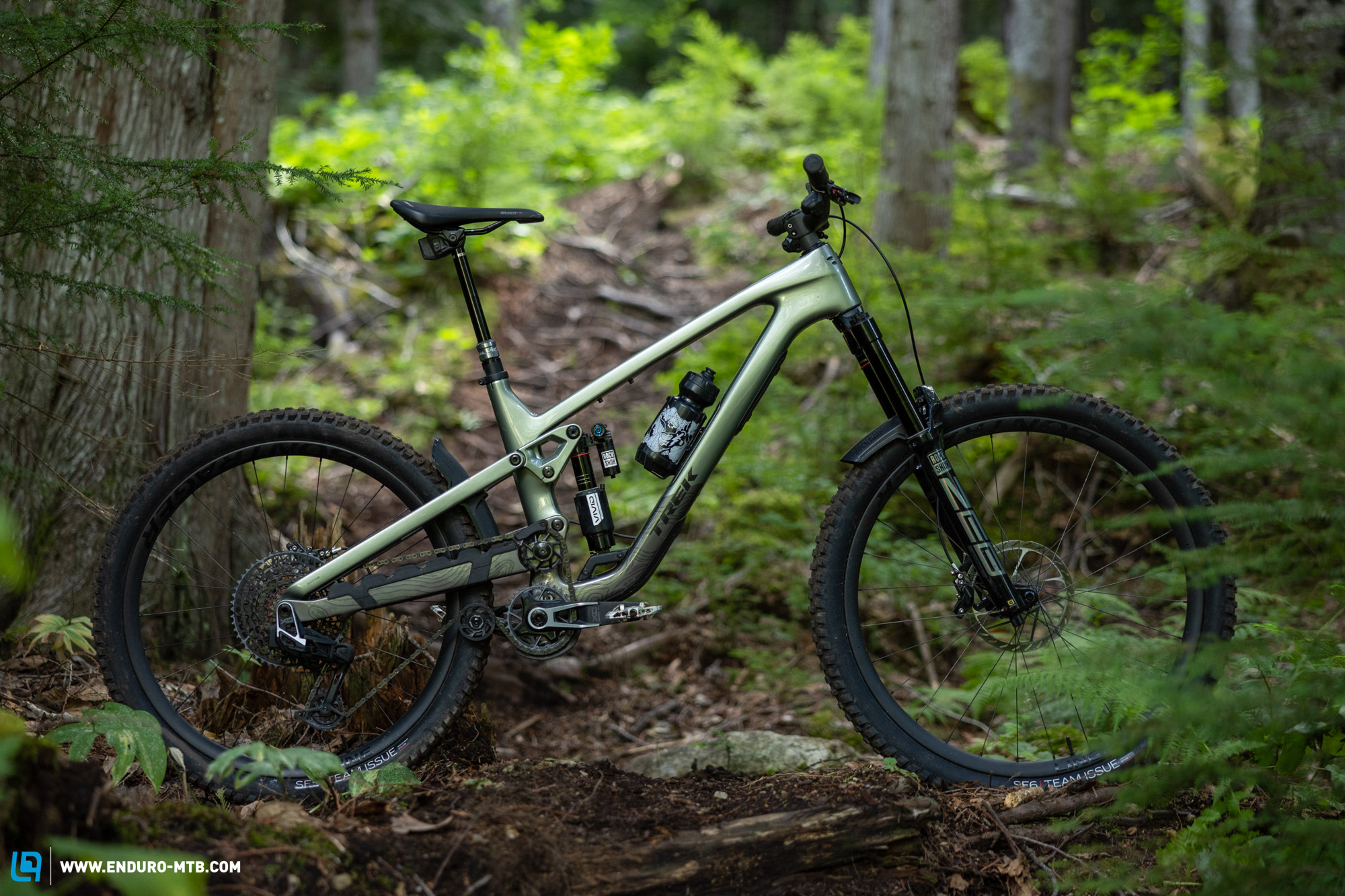
The Slash has been an integral part of Trek’s portfolio for over 10 years, and is now entering its 6th generation. The most significant innovation is the new rear suspension, which relies on a high pivot design and generates a very generous amount of travel, bringing the Slash in line with the latest generation of enduro bikes. Up until now, Trek have only used the high pivot system on their downhill bike, the Session, which nevertheless allowed them to gather lots of practical experience with the system and use their World Cup riders’ feedback to develop the new enduro rig. The new Slash generates 170 mm of travel both front and rear, and rolls out of the factory sporting a mullet. An interchangeable shock mount, however, allows you to convert it to a full 29er. As usual, Trek are releasing both an alloy and a carbon version of the new Slash, both of which are available in several different spec variants. We’ve already put the new Trek Slash 9.9 XO AXS 2024 through the wringer over a 6 month period, dipping its tires both into Canadian and European soil to gather some exciting insights.
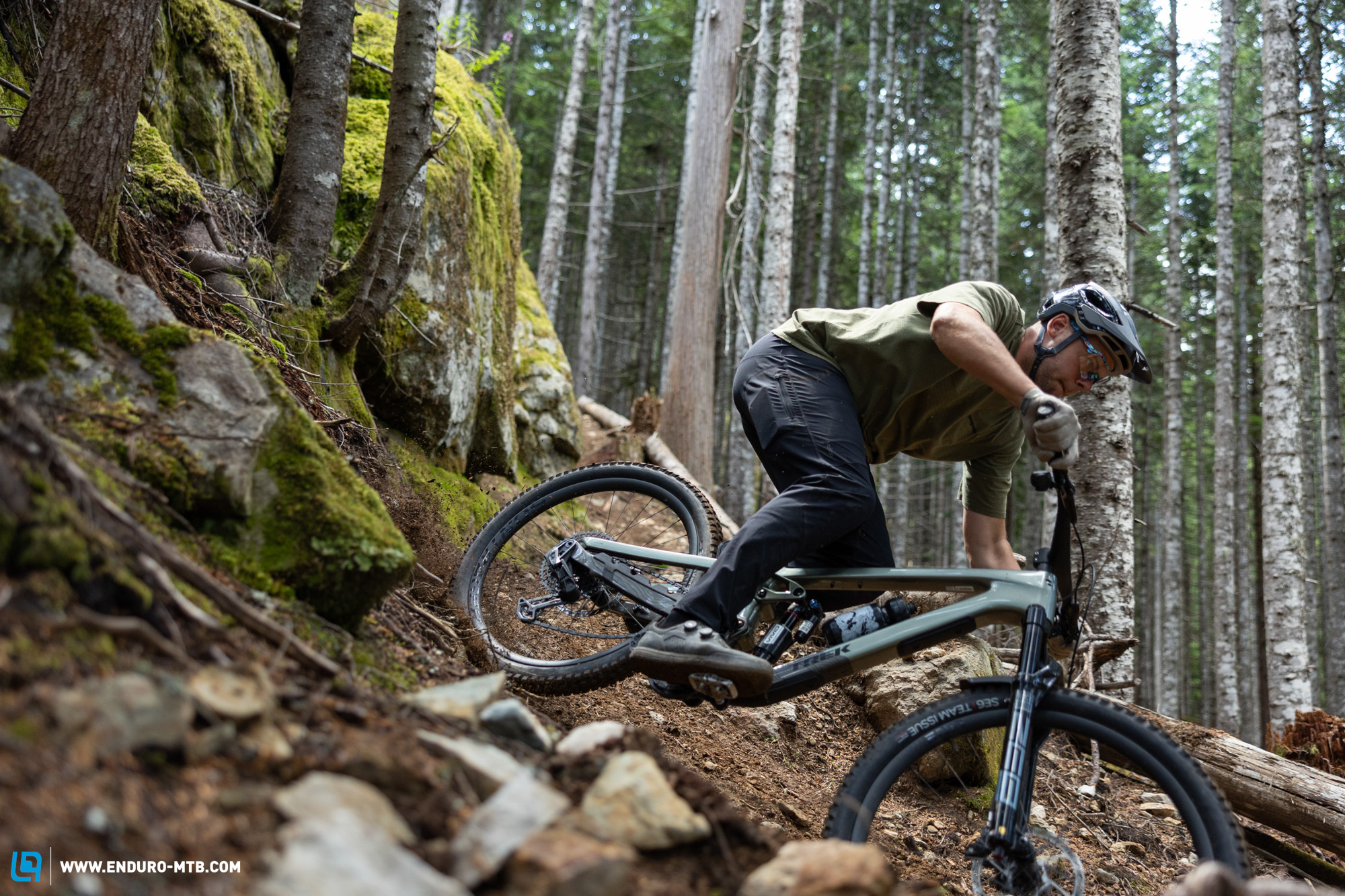
The detail solutions of the new 2024 Trek Slash
The predecessor of the 2024 Trek Slash already came with a practical storage compartment integrated into the down tube, which Trek has updated for the latest Slash iteration. The opening is much bigger, making it easier to reach all the trail essentials you store inside it. Moreover, the edges of the compartment are still framed with a plastic liner, preventing you from cutting your fingers or damaging the contents when you pull them out of the compartment. The alloy frame has a storage compartment too and all models come standard with a small pouch for all your trail essentials, which can be easily pulled out of the frame using the bright red Cordura tab. The closure system relies on a simple lever that disappears under the bottle cage when engaged, and is easy to operate even while wearing gloves. The cables of the new Slash are routed internally and only reappear briefly at the transition from the main frame and swingarm. The cable ports are in a rather unusual position, sitting prominently on the front of the head tube – this look takes some getting used to! In combination with a wireless drivetrain, Trek close the cable ports with small rubber plugs.
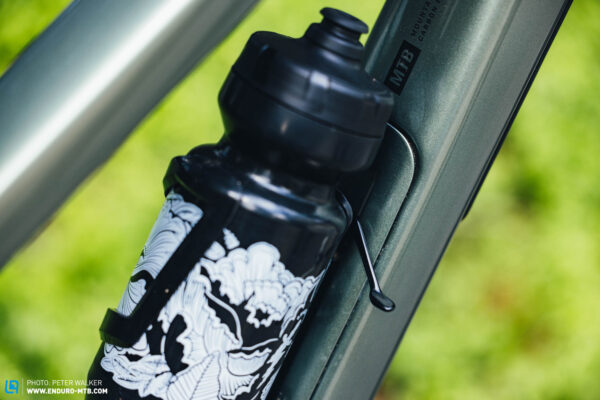
There’s an additional tool mount underneath the top tube, which allows you to carry a spare inner tube or a tool strap, for example. In typical Trek fashion, the new Session comes standard with an integrated Bontrager BITS mini tool in the steerer tube, which includes all of the basic tools required for essential trailside repairs. That said, removing the tool from the steerer tube requires strong fingers and, as usual, the lever of the closing mechanism rattles on the trail. Trek also hide a 6 mm Allen key in the rear thru-axle.
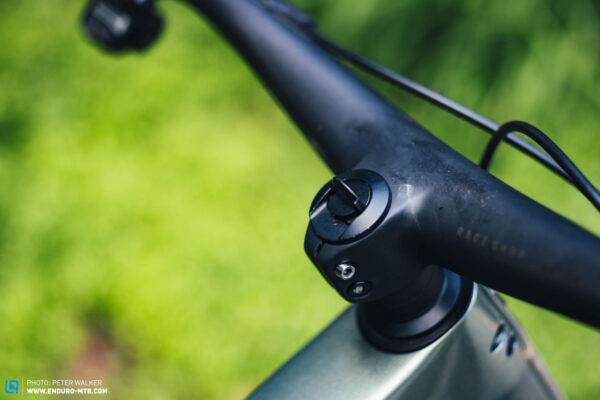
For model year 2024, Trek provided the Slash with several protective features, all of which are meant to preserve the bike’s value. Amongst them is the generously sized integrated mudguard, which is bolted directly to the seat stay and is meant to protect the seat tube from stray rocks. Unfortunately, this has to be removed if you want to swap the 27.5” rear wheel for a bigger 29″ rear wheel. Furthermore, the down tube comes standard with a pair of dual-density TPU plates, which allow you to replace the inner section if it gets damaged. In addition, the frame comes with an additional protective layer under the final finish. Trek also redeveloped the chainstay protector from the ground up, raising both the inner and outer edges to prevent chain slap more effectively – and this really works, ensuring a quiet ride on the trail.
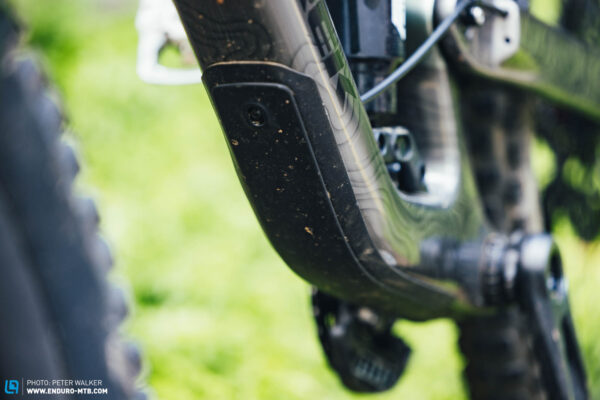
The high-pivot rear suspension of the new 2024 Trek Slash
While the new 2024 Trek Slash 2024 still relies on the same linkage-driven single pivot rear suspension, it combines it with a high pivot point design. This positions the main pivot point well above the chainring, allowing the rear wheel to swing up and backwards during an impact. This rearward axle path can help to make the suspension feel smoother over square-edged hits, ironing out roots and rocks more efficiently. However, the system also has its drawbacks: as the axle moves rearwards through the travel, the distance between the cassette and chainring grows, resulting in wheelbase and chainstay growth. This pulls the chain backwards, manifesting in high levels of pedal kickback and resulting in an imbalanced weight distribution of the rider on the bike throughout the travel. To counteract this, a chain idler pulley is fitted on the seat tube, which helps minimise pedal kickback and also gives high-pivot bikes their characteristic look. This also allows the engineers to fine tune the bike’s anti-squat and anti-rise levels independently simply by moving the position of the idler pulley. The unusually big 19T idler pulley is meant to mitigate the negative effect that the high pivot system has on pedalling efficiency, because the bigger pulley has a wider radius. Furthermore, Trek use a small chain guide to prevent the chain from falling off the idler.
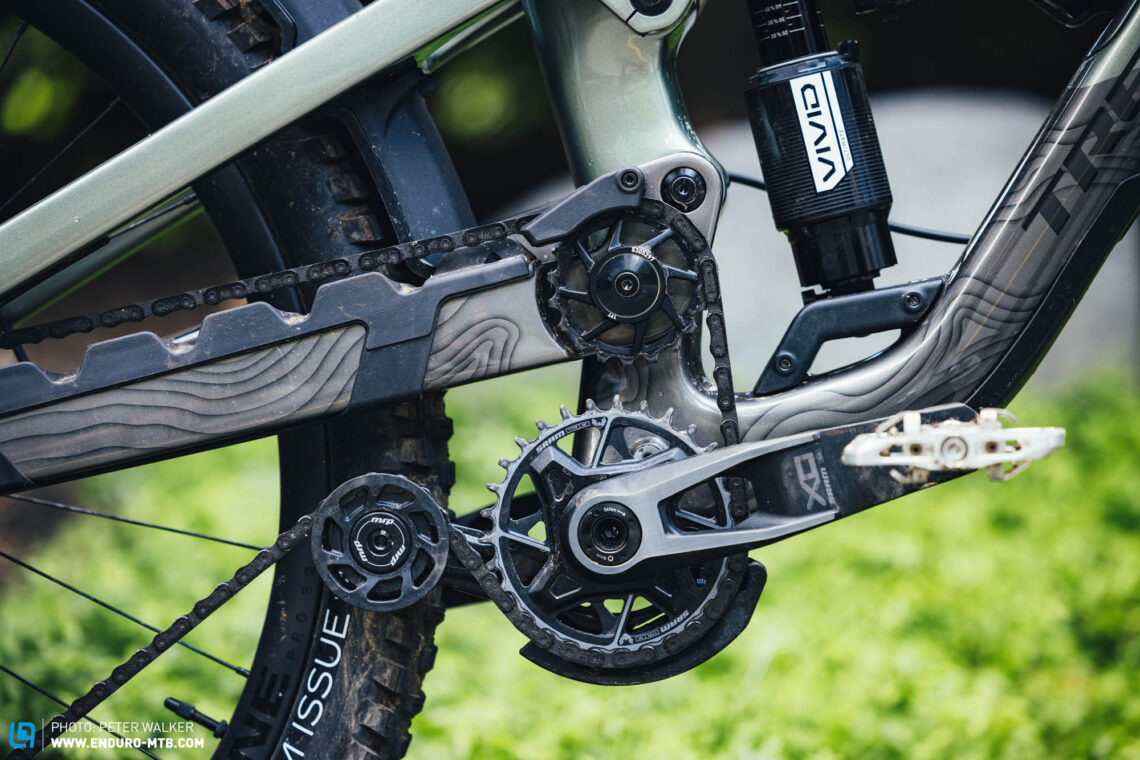
The new 2024 Slash also features an additional pulley below the chainstay, which isn’t that common with high pivot bikes. This special pulley also includes an MRP bash guard and can be retrofitted to other high pivot bikes. Its job is to prevent the chain from stretching under the chainstay and thus to stop it from pulling on the rear derailleur. That said, even with the biggest XL frame, the chain runs at a sharp angle in the lowest gears, as the distance between the rear derailleur cage and the idler pulley is very small. While this didn’t cause us any problems on the trail, we’re not sure how good this is, both for pedalling efficiency and the chain’s service life. Speaking of the chain, with all frame sizes up to L, you’ll get away with a conventional 126-link chain. The new Slash in XL, however, requires 128 links, meaning that you need two chains.
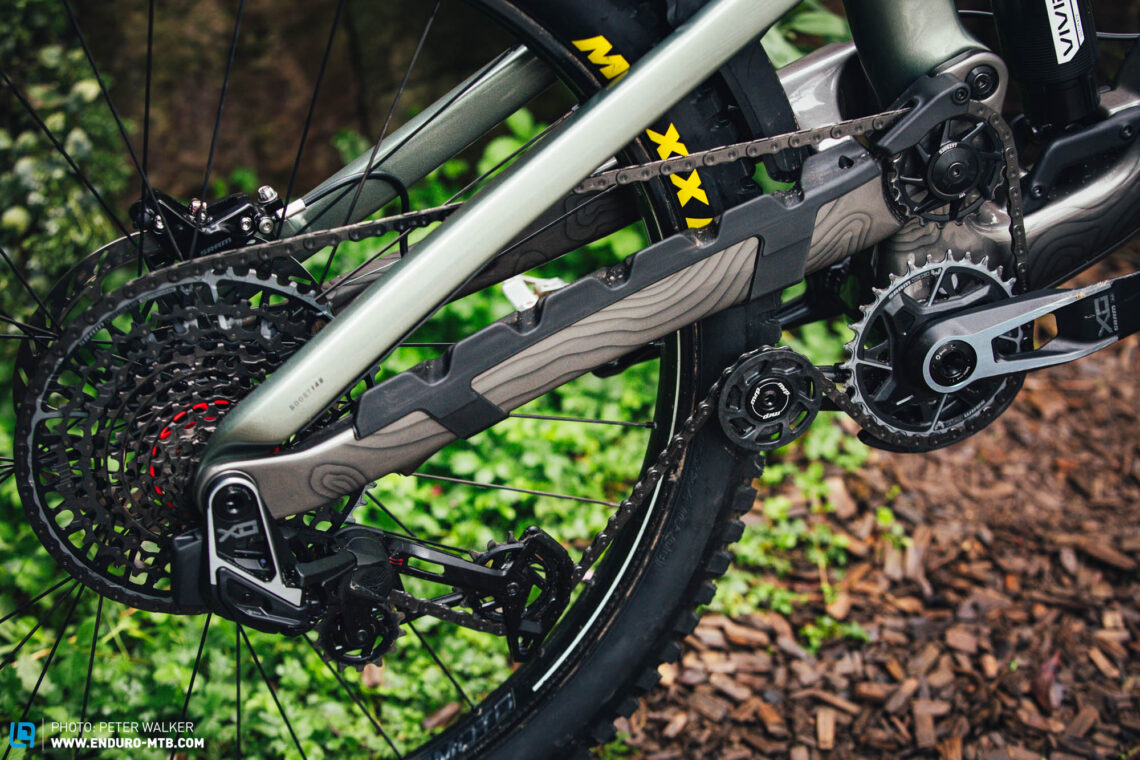
The new 2024 Slash still relies on Trek’s proprietary Active Breaking Pivot or ABP technology, which can be found on most of their full suspension bikes and is designed to keep the rear suspension active even under heavy braking, helping to maintain traction.
The spec of our test bike – The Trek 2024 Slash 9.9 XO AXS
Our Trek Slash test bike comes equipped with Rockshox Ultimate suspension consisting of a 170 mm ZEB Charger 3.0 fork with independently adjustable low- and high-speed compression damping, and a brand- new Vivid Ultimate air shock , which offers externally adjustable compression and rebound settings as well as a climb switch. Unlike the Super Deluxe, the new Vivid relies on a high-volume air chamber and Rockshox’s new proprietary Touchdown damper. Unlike the rest of the Trek range, the Slash doesn’t use a Thru Shaft damper, which comes standard with most of their full-suspension bikes and is developed specifically for Trek.
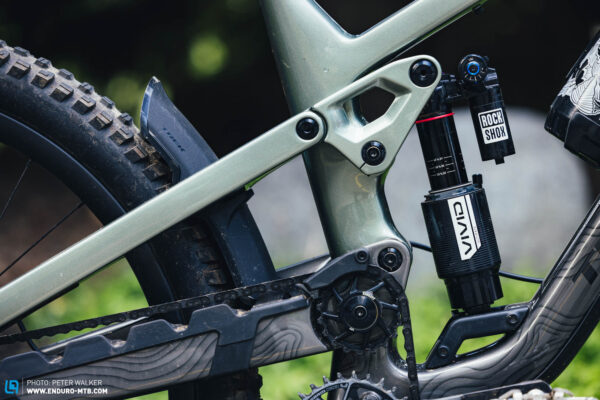
As the name extension suggests, the 2024 Trek Slash 9.9 XO AXS employs a new electronic SRAM X0 Eagle Transmission drivetrain. The rear derailleur mounts directly to the thru-axle and worked flawlessly throughout our test. SRAM also supply the wireless, electronic Reverb AXS dropper post, but this only offers a meagre 170 mm of travel, which is far too little for a modern enduro bike. However, there isn’t a longer-travel version of the Reverb AXS dropper, so we recommend swapping the standard dropper for a cable-operated model if needed. Given the seat tube’s generous insertion depth, you could even push a 240 mm OneUp Components V2 dropper post all the way into the frame of a Slash in size L. Needless to say, the brand-new drivetrain is complemented with SRAM’s four-piston Code Stealth Silver brakes, which, just like the old RSC model, feature tool-free lever reach and bite point adjustments as well as SRAM’s proprietary SwingLink lever for optimal modulation. Compared to the Stealth Ultimate flagship model, the Silver variant only forgoes the carbon levers, tipping the scales at just 8 g more. Due to the new design, the brake lines run parallel and close to the handlebars, which ensures a cleaner look but can cause the cables to rattle – this can be easily fixed with a couple of additional clamps or zip ties ;) The brakes are paired with 200 mm rotors front and rear, which suit the Slash’s character and field of application rather well! For more oomph, you can can upgrade to 220 mm rotors both front and rear, because both the frame and fork are approved for it.
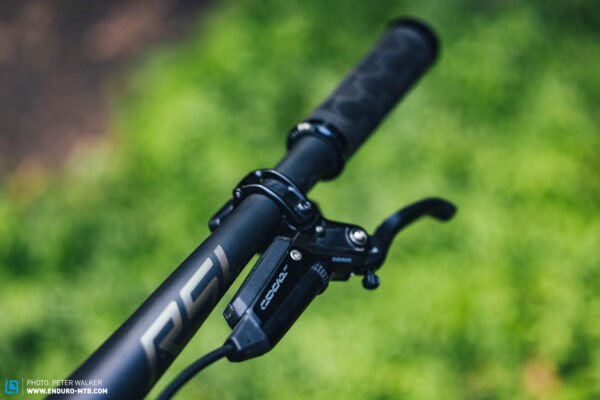
For the rest of the spec, Trek rely on their in-house component brand Bontrager, including a Bontrager Line Pro 30 carbon wheelset, which didn’t survive the testing sessions unscathed, with several spokes snapping after just 3 weeks of deployment. In addition, the rims are paired with flimsy, puncture-prone tires, which force you to run higher air pressure to avoid burping and snake bites. We recommend upgrading the standard Bontrager SE6 and SE5 tires for more robust tires before you start riding. In this test, we swapped to tires with a tougher DH casing after just a few laps. For the cockpit, Trek rely on an 820 mm Bontrager RSL one-piece handlebar/stem unit, which might look fancy but doesn’t allow for fine tuning except for the stem height, which can be changed using spacers. On top of that, the handlebars are very stiff and get even stiffer if you shorten them, like we did! With such a potent enduro bike, an adjustable cockpit makes more sense because it allows you to adapt the front end ergonomics to your anatomy. With the standard spec, our 2024 Trek Slash 9.9 XO AXS test bike in size L tips the scales at 15.7 kg.
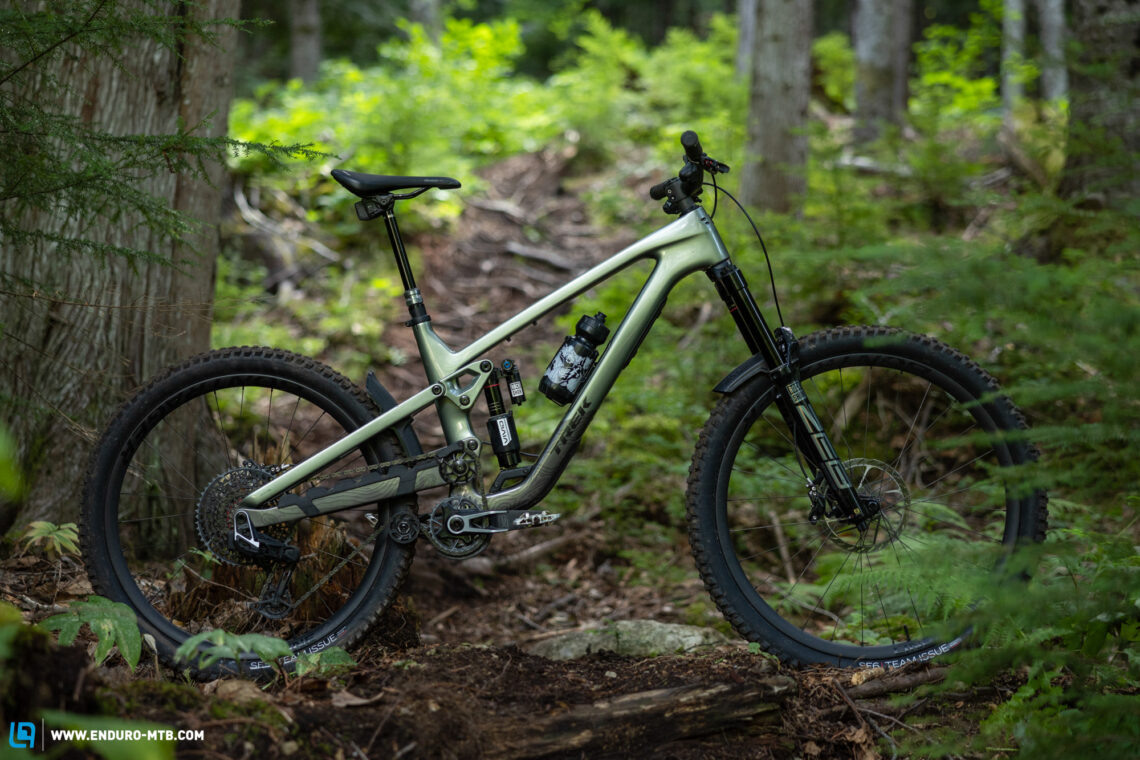
Trek Slash 9.9 X0 AXS 2024
Specifications.
Fork RockShox ZEB Ultimate 170 mm Rear Shock RockShox Vivid Ultimate 170 mm Seatpost RockShox Reverb AXS 170 mm Brakes SRAM CODE Silver 200/200 mm Drivetrain SRAM Eagle Transmission X0 1x12 Stem Bontrager RSL 35 mm Handlebar Bontrager RSL 820 mm Wheelset Bontrager Line Pro 30 29"/27.5" Tires Bontrager SE6 Team Issue/ Bontrager SE5 Team Issue 2.5"/2.4"
Technical Data
Size S M M/L L XL
Specific Features
storage compartment Flip Chip Toolmount
More spec variants of the 2024 Trek Slash
As already mentioned, the new 2024 Trek Slash is available both with an alloy and carbon frame. That said, none of the alloy versions comes with a high-end spec, meaning that you have to order the frame kit if you want to combine an aluminium frame with top-tier suspension, for example. Prices for complete builds range between € 4,499 and € 12,499, and the bikes should be already available from all official Trek dealers. The American manufacturer also lets you test ride their bikes in one of their “Test-a-Trek Centres”. Starting today, you can test the new Slash in Lenzerheide, Saalbach and Sölden.

The alloy version of the new Slash is available in two spec variants. The entry-level Slash 8 XT model comes equipped with a FOX 36 Rhythm fork and a hybrid Shimano XT/SLX drivetrain. Shimano also supply the four-piston Deore M6100 brakes. The Slash 9 GX relies on higher quality RockShox Select+ suspension and SRAM’s new electronic GX Transmission drivetrain, with matching SRAM Code Bronze four-piston brakes. The Slash 9.8 GX combines the same identical spec with a carbon frame.
The flagship Slash 9.9 XX model comes equipped with electronic RockShox Flight Attendant suspension, electronic SRAM XX Transmission drivetrain and wireless RockShox Reverb seatpost. The rest of the spec consists exclusively of top-tier components and plenty of carbon bling. However, all the fancy components come at a price – an eye watering € 12,499! However, Trek have released a total of 5 carbon variants, offering a suitable option for all sorts of wallets.

The geometry of the new 2024 Trek Slash
The new Trek Slash 2024 will be available in 5 sizes, S to XL, and there’s also an intermediate size called M/L. All models in size S feature a curved top tube and 27.5″ wheels front and rear. From size M onwards, the new Slash rolls on a mixed wheel setup with a 29″ wheel at the front and smaller 27.5″ wheel at the rear. However, from size M upwards you can also use a 29″ rear wheel using a different shock mount, but this has to be bought separately and isn’t included in the frameset. The optional shock mount comes with a flip chip that allows you to change the progression of the rear suspension from 20% to 25%, which is intended for coil shock conversions.
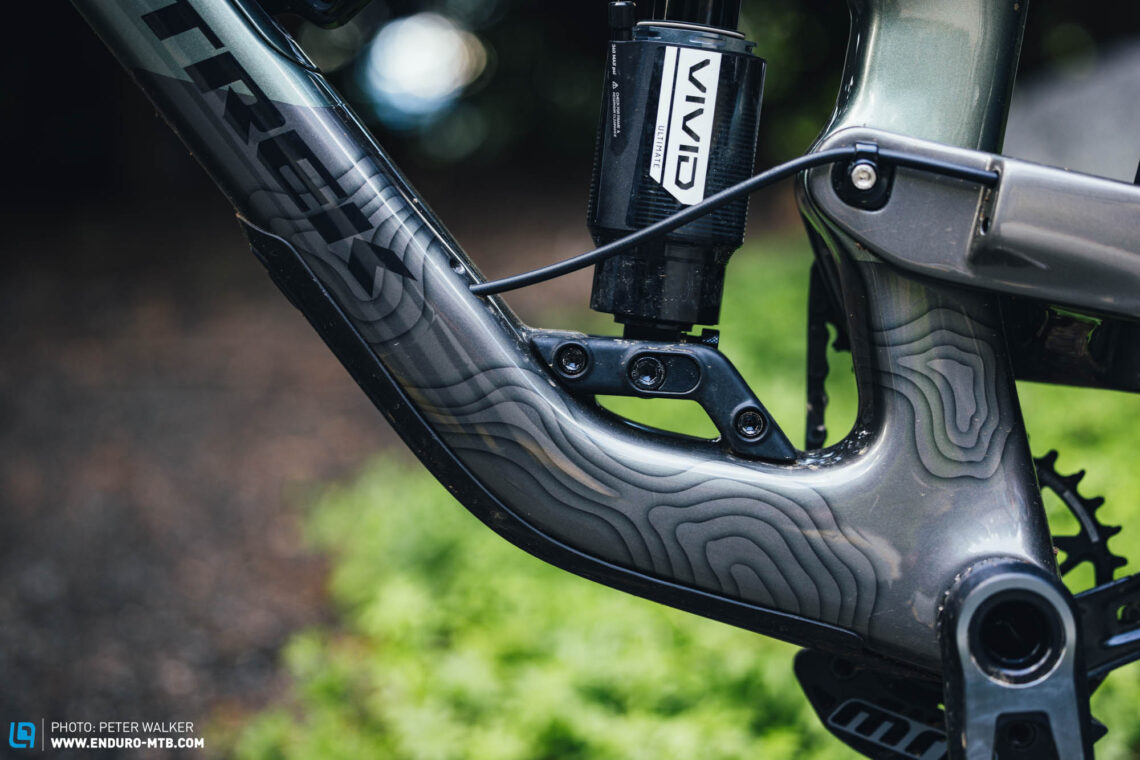
Trek deliver the new Slash with three different headset cups, which allow you to change the head angle by up to 1.5°. Of course, by altering the head angle you’ll also change the reach, bottom bracket height and stack height. The new Slash comes standard in the neutral setting. When swapping the cups, however, the lower one has to be installed with a bearing press, meaning that you can’t just quickly swap cups on the trailside. In the neutral setting, the Slash has a 63.3° head angle, which can be changed to either 62.6° or 64.1°. In addition, Trek forgo their usual Knock Block with the new Slash, which means that you don’t have a steering stop limiter.
The position of the bottom bracket allows engineers to achieve different chainstay lengths by using the same rear end, whereby sizes M/L and L share the same values. Simply put, all frame sizes share the same identical swingarm but rely on a slightly different bottom bracket position to allow for the size-specific effective chainstay length. The advantage of this system is that you can easily replace the rear end in case of damage.In size L, the Slash combines 488 mm reach with a short 435 mm seat tube, which offers a generous insertion depth for long-travel dropper posts. The seat tube is short across all sizes, ensuring sufficient freedom of movement on the trail.
The geometry of the new 2024 Trek Slash in the neutral setting
The new 2024 Trek Slash 9.9 XO AXS on the trail
For this review, we were able to ride the new Trek Slash 9.9 XO AXS 2024 in both size L and XL. We tested the bike over the course of several weeks, putting it through the wringer on the legendary trails of Whistler, Squamish and Della Creek, both on bike park trails and natural trails – and also managed to squeeze in a few laps with freeride legend Andrew Shandro. We also rode the new Slash (in size L) on our home trails around Stuttgart and on some techy Alpine gnar in Switzerland. Testing the new Slash in different frame sizes and countless locations gave us the opportunity to gather plenty of impressions.
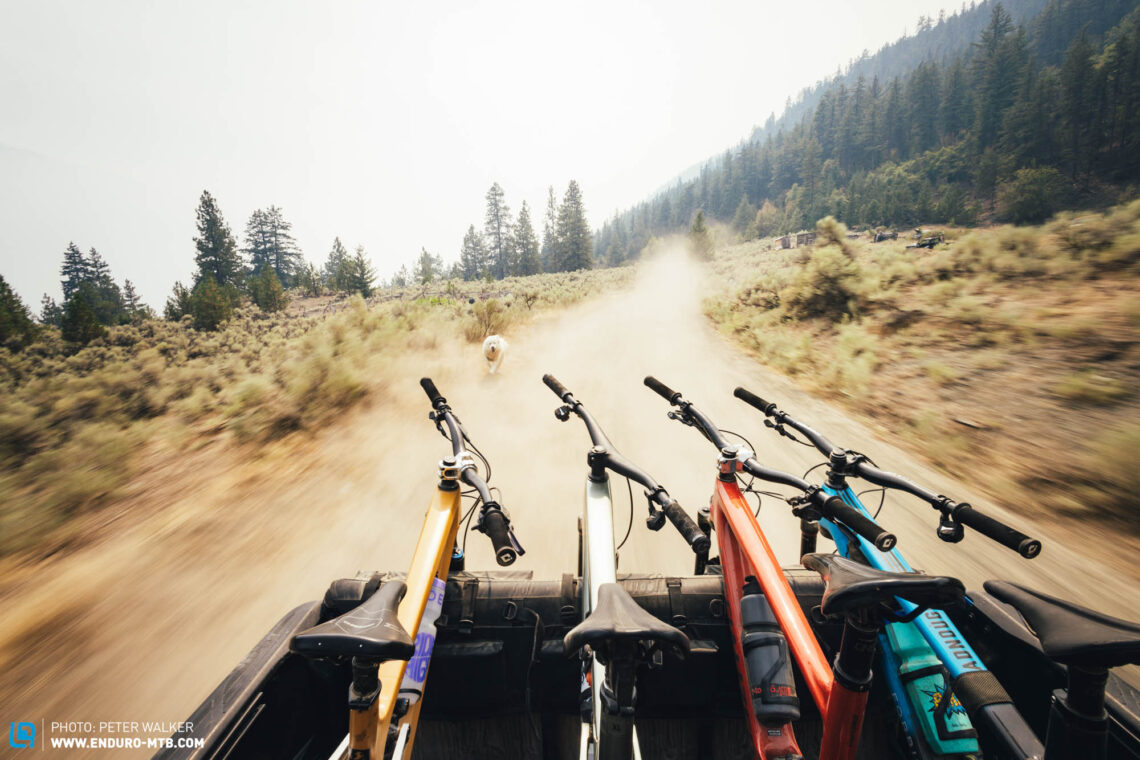
Needless to say, an aggressive enduro bike won’t earn you any uphill KOMs, and yet the new 2024 Trek Slash 2024 gets you to the trailhead without too much effort. The rear suspension only bobs slightly and generates plenty of traction on technical climbs, meaning that you can easily make your way to the top of the mountain without reaching for the Vivid’s climb switch. On steeper climbs, the front wheel remains planted on the ground, ensuring excellent steering precision. While on the first test laps the bike was totally quiet, with the idler pulley working discreetly in the background, this changed after a few days, with an increasingly loud rattling noise accompanying us on every climb.
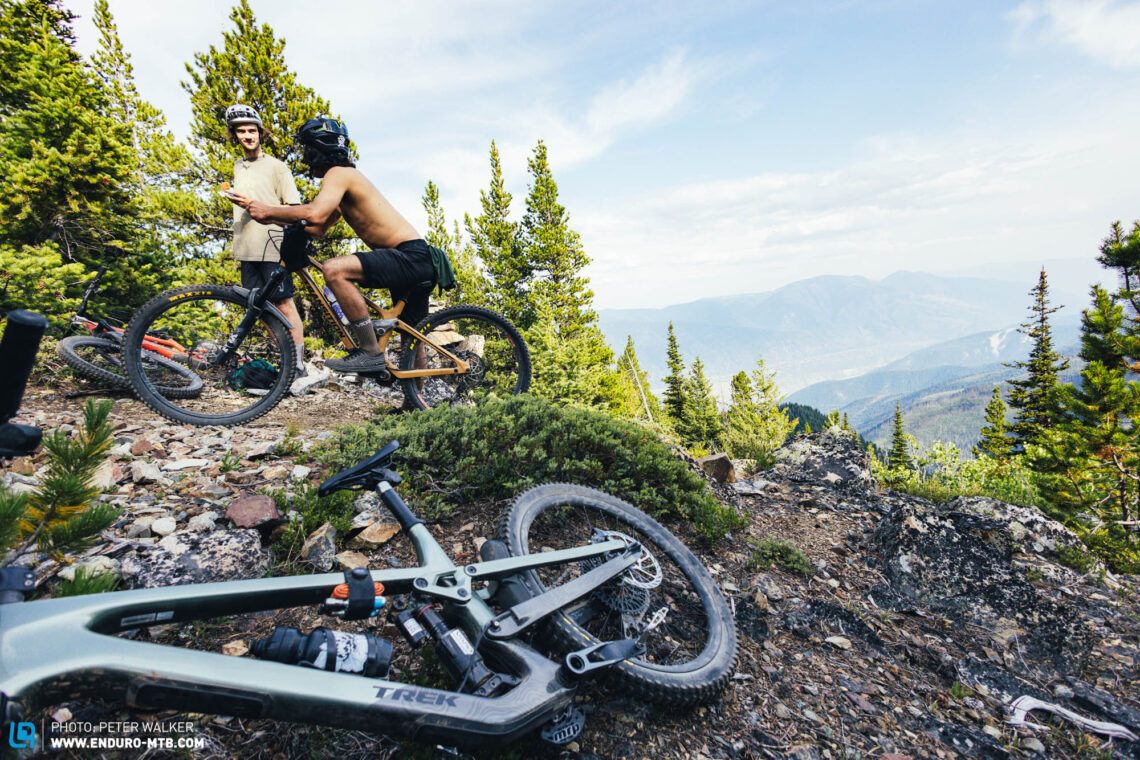
When gravity takes over, the first thing you’ll notice is the high front end and deeply integrated riding position. This inspires huge amounts of confidence, even on the gruellingly steep Canadian trails. The Slash makes you feel at ease from the get-go, encouraging you to keep your fingers off the brakes after just a few corners. If you do brake – which is inevitable from time to time – the rear suspension generates tons of traction without stiffening up excessively if you hit a large bump while decelerating. The wheelbase of the Slash grows noticeably less than with other high pivot bikes, remaining agile and playful even when fully compressed. Overall, the rear suspension provides plenty of support, allowing you to pop off ledges and kickers while at the same time offering enough reserves to cope with botched landings.
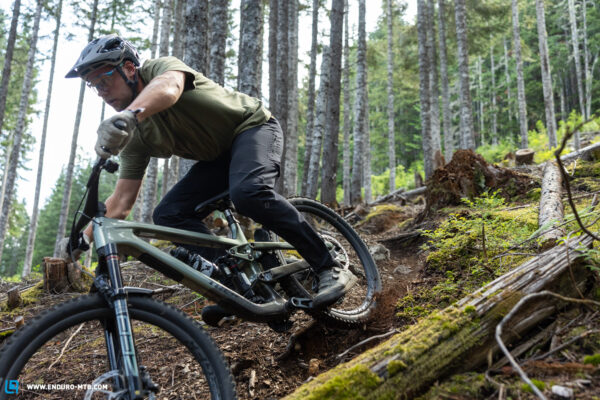
The new Slash has direct handling and reacts to steering input quickly and precisely. During this test, we swapped the original wheels and handlebars for alloy models, which helped mitigate the very direct ride feeling, ensuring more forgiving handling in slippery conditions. Even in open corners, the Trek sticks to the chosen line with great composure and doesn’t require you to actively weight the front wheel – and that’s despite the high front end! As a result, you’re always in a central riding position, which conveys huge amounts of confidence in all situations. Overall, the Trek makes you feel as if you had more travel on tap and at the same time is just as agile and playful as bikes with less travel. Trek also seem to have successfully addressed the typical drawbacks of high pivot bikes, like the sluggish handling and unbalanced suspension performance, which can result from the growing wheelbase.

Who should take a closer look at the new 2024 Trek Slash?
The new Trek Slash is aimed at trail rippers, enduro racers, park rats and anyone who likes to get rowdy on gnarly trails. Provided you perform a few basic upgrades, like more robust tires and a tuneable cockpit, the new Slash offers a pretty sweet overall package – we’re pretty chuffed with it ourselves. Even on slower, narrower trails, it’s refreshingly nimble, while the excellent suspension allows you to generate speed by pumping through flow trails, which isn’t always a given with high pivot bikes. In our humble opinion, the Trek Slash 2024 is the next evolutionary stage of high pivot bikes, bringing all the advantages of a high pivot suspension design while at the same time eliminating most of its drawbacks.

Our conclusions about the new 2024 Trek Slash
The new Trek Slash 2024 offers agile, balanced handling and combines it with all the positive traits of a high pivot suspension design, ensuring excellent composure and a plush ride. If you like to open the taps on gnarly enduro trails, we recommend upgrading a few components. This will allow you to boost the Slash’s trail performance enormously with relatively little effort and at a reasonable price. The new Slash slaps a huge smile on your face, whether you’re going for a quick post-work ride on your home trails, racing enduro in the Alps or lapping park tracks – and also makes a great companion for the occasional flowing trail.
- Integrated, confidence inspiring riding position
- Combines excellent composure and agility
- Potent suspension provides plenty of pop and reserves
- Practical features like the integrated storage compartment and mini-tool
- Spec has some blemishes
- Idler pulley grinds lightly when pedalling uphill
For more info, visit Trek’s website.
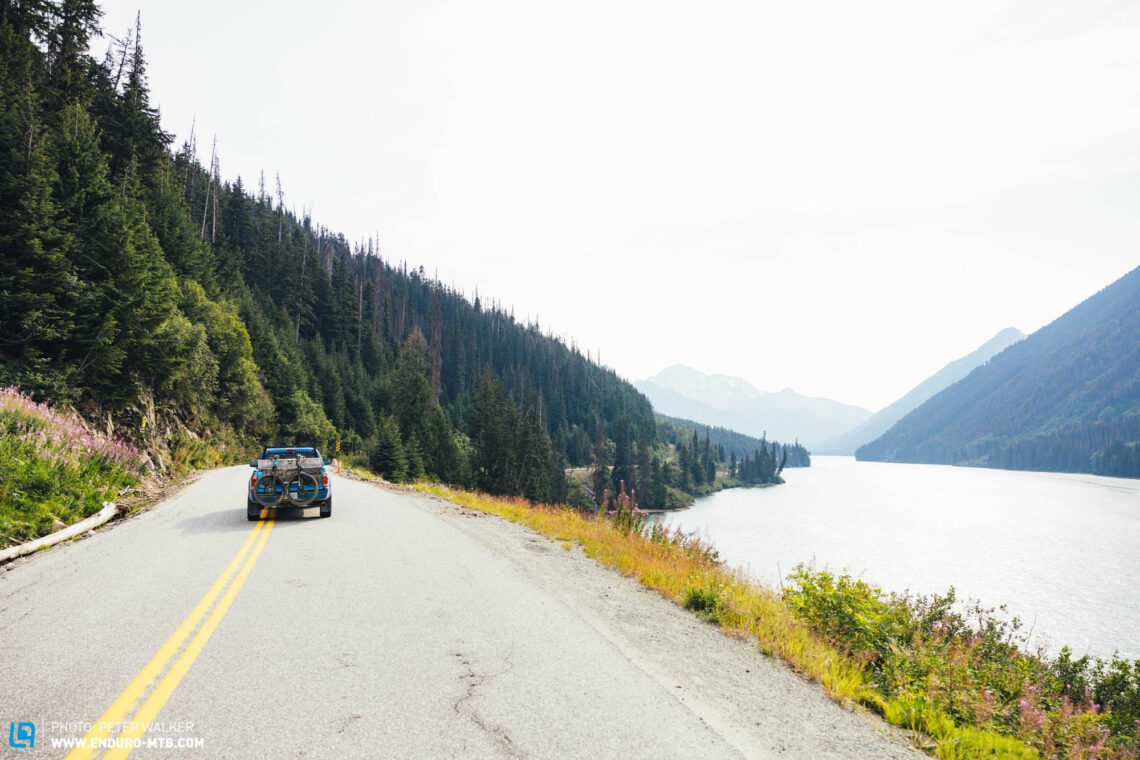
Did you enjoy this article? If so, we would be stoked if you decide to support us with a monthly contribution. By becoming a supporter of ENDURO, you will help secure a sustainable future for high-quality mountain bike journalism. Click here to learn more .
Words: Peter Walker Photos: Sterling Lorence, Peter Walker
You may also like

New MAXXIS HighRoller 3 tire on test – Ciao ASSEGAI?

Already have plans for this weekend? Come visit us!

The intelligent MTB – What if…?

2024 Ibis Ripmo on test – Our Best in Test’s little brother

Enduro Trends 2024 – The 6 most important trends and findings from...

2024 Lapierre Spicy CF – We exclusively tested the hot new 2-in-1...
About the author.

Peter Walker
As editor-in-chief, Peter is as much a man of action as he is of words. This expert, screw-driver-flexing two wheeled-whizz has many envy-inducing characteristics, including a background in motocross, several EWS race plates to his name, and more than 150 recorded days at Whistler Bike Park. However complex the bike and however steep the trail, he’s probably already nailed it, twice. Oh, and he can do it all on skinny tyres too. When it comes to guiding consumers, Peter cut his teeth at Vancouver’s oldest bike shop and now puts pen to paper on the daily translating this know-how into our editorial plan. When not tearing up Stuttgart’s local trails while testing bikes, he loves nothing more than loading up his self-renovated VW T5 and hitting the road. The fact that he’s a trained paramedic gives his colleagues reassurance out on the trails. So far we haven’t had to call him by his alias ‘Sani Peter’, so here’s hoping he keeps it right side up for the rest of his time here!
Trek Slash 9.9 Gen 6 review – a high pivot and idler suspension design, plus a completely new chassis
With 170mm travel and a complex high pivot layout with upper idler wheel and lower guide, trek’s new slash prioritizes bump swallowing and dh capability without sacrificing the ability to be a sorted enduro all-rounder.
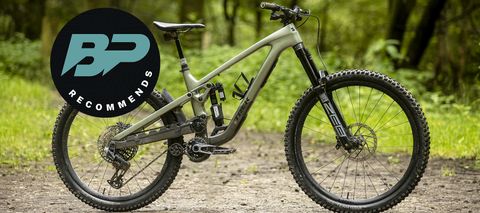
Bike Perfect Verdict
Contrary to what you might expect, Trek’s headline shift to a more rearward axle path and more DH-focused suspension doesn’t mean its latest Slash can’t cut it as a well-rounded and efficient enduro rig. I found it engaging and tons of fun when working as intended, but did have some serious issues connected to the added complexity in the drivetrain layout.
Smooth, calm and balanced ride
Whether pedaling or pushing into the suspension for extra terrain speed, the Slash offers great support
Big idler and guide wheels pedal really smoothly
Nimble and maneuverable
Great chassis feel and tidy finish and details with plenty of adjustability
Very quiet and well protected
Drivetrain complexity introduces some potential issues
Own brand Bontrager wheels and tires wouldn’t be my choice
Doesn’t roll as fast as some 29-er enduro bikes
Reverb dropper won’t be long enough for taller riders
No classic, completely bump-erasing, glued-to-the-floor feel of a high pivot
Why trust BikePerfect Our cycling experts have decades of testing experience. We\'ll always share our unbiased opinions on bikes and gear. Find out more about how we test.
With its high pivot suspension and idler setup, Trek’s latest multi-adjustable Slash looks a lot like a Session DH bike , and is also about as on-trend for a 2024 mountain bike as you could imagine (except maybe if it was electric too).
As well as bringing the latest tech from downhill racing, the Slash 9.9 X0 AXS T-Type Gen 6 ups travel closer to DH levels with 170mm at both ends, compared to the 160mm rear on the older version. The all-new Slash frame also has slightly slacker geometry, although the angles are pretty standard ‘enduro bike territory’ and not that radical for a bike that looks this radical.
With its rowdier attitude, huge idler wheels and a lot of chain going on in the middle of the bike, the latest Slash definitely looks funky and it’s easy to imagine it working best for a downhiller or lapsed freerider who only needs/wants one bike in their arsenal able to access the steep stuff under their own steam. Once I rode this new Trek though, I quickly realized any assumptions of one-dimensional, DH-focused, performance weren’t actually that accurate.

We’re now up to the sixth Slash generation, so plenty of familiar and proven technologies remain like Trek’s OCLV carbon construction and an ABP rear pivot. The frame offers tons of adjustment, including the ability to switch to 29in wheels like the older Slash rather than run the stock MX setup. The mullet wheels here use proprietary Bontrager carbon rims and tires.
Trek pairs RockShox’s new Vivid Air shock and its several inches higher main pivot with a 170mm RockShox Ultimate Zeb fork up front. On this 9.9 model, the chassis is full carbon everywhere with downtube storage and fully tricked out with SRAM electronics, including a T-Type Transmission with Pod shifters and an electric Reverb AXS dropper.
Despite its headline downhill orientation, the new Slash is still designed for efficient pedaling and climbing and Trek has clearly done a ton of work on the suspension configuration to balance pedaling and descending qualities that I’ll delve into later. The all-new Slash is available in various models, from this high-end carbon fiber version that’s nearly ten grand to more affordable aluminum frames starting just over $4,000 / £4,000. And, because of the added complexity and weight in this new layout, Trek also continues to offer the Gen 5 Slash as a lighter and simpler alternative.

Design and geometry
Trek’s Slash has consistently evolved year-on-year, but one trademark has always been offering a smooth ride and excellent tracking under braking. Seeing as this is often touted as a major reason engineers choose to adopt a high pivot suspension design, you might question its motives, but with its improved rear axle path and superior bump swallowing, the design has become the one many brands are adopting in the gravity sector for ultimate suspension performance.
The high pivot here brings the advertised benefits of the wheel moving backwards in the direction of bump forces to enhance momentum and stability in rough terrain and is part of a system using Trek’s ABP (Active Braking Pivot). That final piece allows the chassis to rotate a touch around the rear rotor under braking, so it doesn’t lock up the suspension and the new setup here bolts SRAM’s T-Type rear mech into the frame together with the Boost rear axle. The way it is integrated is all pretty slick (just like the rest of the frame’s finish) and at the back of a hugely protected chainstay, the ABP pivot tightens up around the axle with a cassette tool if you need to service it, which is a pretty neat touch.
The main reason for moving the main pivot higher is for a more rearward axle path, but a drawback of this is impacting the suspension in other ways; most notably increasing the distance between rear axle and front chain ring as the suspension moves. This increases chain growth, which ups pedal kickback (a force pulling the cranks backwards deeper in the travel) and can feed back to the rider as harshness in the leading leg and inhibit free suspension movement. Trek’s (bigger 19t) upper pulley wheel is all about negating this effect and retaining the benefits of a high main pivot. By routing the chain around an idler pulley and controlling the distance between the axle and the high main pivot, the brand can better control any pedal kickback.
And, yes, all this adds all the drivetrain complexity you can see when combined with an extra lower guide for chain stability. But while Trek’s previous Slash saw anti-squat dip to 20 percent by the end of the bike’s travel, its engineers have delivered 100 percent anti-squat throughout the travel on this Gen 6 model using the new complicated suspension layout. Consistent anti-squat throughout the travel means the Slash should pedal efficiently without bobbing anywhere while climbing or sprinting and (equally importantly) have a consistent and predictable feel in terms of support and speed generation in compressions and berms.
Combining this aspect of tuning with the rear ABP pivot that helps control anti-rise by partially rotating as the bike reacts to braking forces on the suspension (and how much it wants to extend up under braking), gives Trek’s boffins a potent recipe for tweaking suspension performance under pedaling, braking and bodyweight inputs.
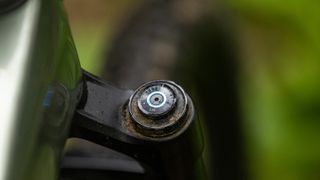
In terms of construction, this 9.9 level frame is carbon throughout with a shock rocker that’s part magnesium, and uses Trek's OCLV carbon technology, which improves strength and impact resistance by better compressing carbon layers and purging fillers.
Trek keeps the old(er) school stuff where it makes sense, including the 73mm BSA threaded bottom bracket and internal cable routing that avoids annoyingly going inside your headset bearings like plenty bigger brands are doing. The Slash cable routing minimizes tube rattle to the point it’s non-existent and also maximizes internal frame space inside Trek’s downtube stash.
Alongside the very chunky sculpted chainstay guard, there’s a metal plate on the interior of stays where the chain can potentially slap and rub against the carbon and even an impact-resistant laminate under the paint for extra durability everywhere. Slash stays can handle fatter rubber (up to 2.6in), offer good mud clearance and a mud guard, and there’s more frame protection behind the BB and under the downtube where removable plastic guards defend against rock strikes and shuttle damage.
Gen 6 Slash comes with a 170mm fork that gives a slightly slacker 63.3-degree head angle, but it’s also rated for up to 190mm fork if you want to go full ham on the downhills or hucks. You can adjust the head angle without changing fork stroke too with Trek’s aftermarket adjustable headset cups or fiddle with the lower shock mount and flip the leverage rate between less or more progressive. Riding with less ramp up (like I did) offers a plusher feel and a smoother and more supportive mid-stroke, and flipping it makes it more progressive for when you’re riding fast, hitting big features and want extra bottom out resistance (or are running a more linear coil shock).
I found the 77-degree seat angle pretty much spot on for climbing without being too steep to pedal longer distances or feel cramped in the cockpit, and across a broad range of sizes, Slash chainstays grow in length from just under 430mm on the M to almost 440mm on the XL. The M/L I tested had just under 470mm reach and foot-to-hand distances range from 448mm to a rangy 513mm on the biggest frame; all with a 351mm static BB height sounds reasonably tall, but doesn’t feel at all high when you’re actually riding.


Components and build
This Slash 9.9 model costs nearly ten grand, so it’s a shame that quite a few parts here had Bontrager written on the side. I didn’t like the grips’ uncomfortable lock rings, but that’s no big deal, unlike the sketchy SE5 and SE6 tires that really affect performance. Despite a decent tread pattern, the 2.5-inch pair use a finer weave 120tpi casing that lacks damping and protection and makes them too flimsy and thin for serious downhill riding. To top this off, the rubber compound feels perilously slick on wet rocks and roots too.
During testing, I replaced them with Michelin tires, which offered way better grip and stability, and from what I can see, even Trek’s top enduro racers, like Hattie Harnden, do the same and opt for Continental tires with logos blacked out for World Cup events. Swapping tires is a bit of a must to match the Slash’s DH capability and you’ll need to factor in another $100 / £100 or so for this.
The Bontrager Line Pro 30 carbon wheels are also not to my taste. They proved really strong, constantly hammered into rock slabs on full-on DH tracks and provide a razor-sharp, quick-to-accelerate feel, but this also makes the ride edgy and harsh and lacking in the compliance and tracking many modern carbon rims now offer. I tried to mitigate this effect by reducing spoke tension half a turn, which improved comfort slightly, but one nipple on the rear wheel fully unwound and I had to take Bontrager’s clever, tubeless tape-avoiding, rubberized rim strip off to reseat it.

Trek’s one-piece carbon bar/stem combo looks slick and is lightweight, but it has its downsides too. You can’t adjust stem length or bar shape if the shape and fit don’t suit, but I can’t comment on ride feel as a previous tester had cut it too narrow for me to try. RockShox’s Reverb AXS dropper post maxes out at 170mm travel, which worked well enough for me and (even though it requires charging another AXS battery) the lightness of operation makes it one of my favored droppers, but the tallest riders might want more drop.
On a more positive note, SRAM’s Code SLR 4-piston brakes with 200mm rotors deliver consistent stopping power and the latest T-Type transmission with a 10-52t cassette is rock solid. Even with all the complications, Trek’s drivetrain is surprisingly smooth and delivers seamless shifts using SRAM’s new adjustable Pod shifters, which greatly improved thumb positioning over older designs. I got so used to the Pods in fact that mechanical shifting felt weird and archaic switching back to it, which is the first time that’s happened since electric gears came out.
SRAM’s 165mm XO1 cranks are stiff and solid and provide extra ground clearance too, but I did have a major issue with the AXS XO1 T-Type rear mech. While it withstood impacts and rock strikes like a champ, the AXS battery was knocked off while riding and completely lost in the forest. Fortunately, I had a spare with me in Italy, but this could be a major problem during your race or ride holiday. The battery’s placement hanging off the back secured by a small plastic tab is a bit of a design flaw SRAM seems to be aware too, as the newer GX Eagle T-Type mech has the battery relocated on top for better security.
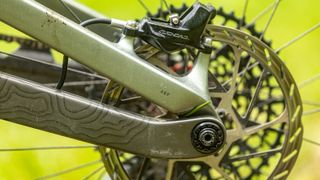
Ride, handling and performance
Forget any ideas of excessive drivetrain drag and a soft feel under power; this new Slash pedals and climbs pretty well by any standards, not just compared to other long travel enduro bikes . Even with the complex design, it’s not that heavy for the category either and smooth and zippy while supporting rider weight evenly whether spinning or stomping.
The seated climbing position is comfy and well-balanced to keep you centered, and the way the back tire maintains traction on steep climbs without wheel-spinning is properly impressive – that rearward axle path is clearly doing something extra and rubbing out small hook ups so the rear tire bites and drives on slippery or loose surfaces stood up or sat down.
Even threading the complicated sequence of 19t upper idler, X-Sync chainring, lower guide and that massive T-Type mech and cassette, the chain is quiet and smooth rolling when properly lined up and the suspension never really wallows or bobs on the downstroke either. I read elsewhere some owners have issues with rumbling, but this bike stayed really quiet for me.
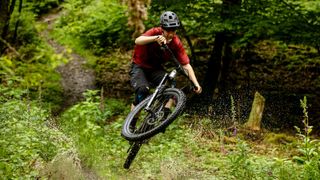
I’m not the biggest fan of climbing and very sensitive to anything slowing me down, but while this clearly isn’t a downcountry bike , it also avoids too much wasted energy, even sprinting along the flat or sneaking cranks in coming up to a big jump or something where some long travel bikes can really bog you down. Wherever you are in the travel, there is a real smoothness to the pedaling too, which backs up Trek’s claims of the near constant 100 percent anti-squat making it pedal more like its 120mm travel Top Fuel .
At this point I could go off on a real tangent and spout my half-baked theory that for flat pedal riders like me, bikes with more consistent (or lower) anti-squat numbers generally pedal more smoothly and with less of a surge/dip cycle that can feel choppy and introduce more bob. Flat pedal riders put more emphasis on the downstroke relative to clipped in riders who spin smoother circles, and I wonder if it’s something bike tuners and engineers (who as experienced or ‘expert’ riders are more likely to be clipped in) take into account, considering how many potential customers ride flats. This theory is definitely something for another day though, and maybe Trek’s engineers agree with me seeing as the new Slash pedals very neutrally anyway.
Trek claims the idler setup does add a small percentage of drag, but I reckon the T-Type drivetrain helps cancel some of this effect too by being super smooth, stiff and perfectly aligned on any bike. I can’t comment on whether the efficiency would be as good on a Slash with lower-tier kit. Despite the sharpness in power delivery, this is still a 170mm bike though, so I found the active rear end benefits from flipping the Vivid Air into the locked position for longer climbs on tarmac or smooth gravel fire roads where super-active suspension isn’t needed.

On the downhill and steep tracks where the Slash is most optimized, the suspension design kind of mirrors the pedaling performance. It somehow doesn’t scream ‘high-pivot suspension’ and overly glued to the floor, instead the main sensation is smoothness and control.
The Vivid shock (or back end) feels fantastic absorbing impacts without ever hooking up, while still supporting rider weight and not feeling bogged down and mushy in the midstroke. This perkiness and on-its-toes feel isn’t ever at the expense of bump swallowing either and the rear suspension is also highly active with excellent ground tracking and the ability to keep working even under hard braking.
Calm and collected it might be, but the Slash’s handling still lives up to its name by being plenty reactive, making it easy to dart about on technical terrain and execute cutties or Scandi flicks as happily as just smash it down the middle line and rely on the rear travel. It’s pretty easy to manual and pays back when you pump for speed. There’s a great sense of balance between the Vivid and the Zeb too, so you’re never getting pitched about on the steeps or feel like rider weight’s falling off the back. RockShox’s DH air shock is so good, it genuinely feels like a coil spring on ripple hits or sharp edges in terms of muting trail feedback brilliantly, plus it’s obvious what all the adjustments are doing so you can tune it to taste really easily without ever messing up the overall balance or performance too much.
Part of the Vivid’s gentle touch is due to the clever Touchdown design inside, which bypasses any compression damping for the first 10 percent of travel for extra sensitivity off the top and ground connection. Deeper in the travel, the Slash’s rear end controls and dampens impacts with smoothly building support, while feeding back plenty of trail information, so it never feels too dead or limp.
In terms of handling, the Slash is very neutral but can also react quickly to body weight shifts and little lifts and lofts out of turns or off-trail features. The M/L I tested is slightly shorter than many enduro bikes I review, but with the extra travel and high pivot that sees chainstays grow marginally in the travel, it feels as stable as a larger bike somehow, and I enjoyed the tighter dimensions and slightly more nimble handling. My guess is that the 490mm reach size Large might feel pretty big compared to other Large sized enduro bikes.
Trek’s Slash factor extends to jumps too, where the bike carves up and pops off lips without feeling soggy, even when set up for a very supple, ground-tracing feel at the shock. One of the best traits of the Slash everywhere is offering loads of smooth support at the back and how it maintains stability and avoids any sensation of the front end feeling a bit light mid turn and rider weight falling off the back a bit, which is something I’ve had before on some MX high pivot bikes.
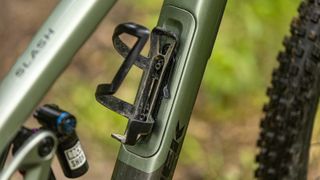
The Slash’s carbon frame has a new storage cupboard door that’s easier to open and the inside is bigger; the chassis feels solid and stiff too and able to hold straight in hectic lines without harshness or unexpected flexing. There’s also the adjustability for riders to tweak the setup for different riding styles and conditions, but I pretty much liked the Slash out of the box and didn’t even bother messing around with it.
While there are loads of positives to shout about with the Slash’s ride quality, it’s not without some major issues elsewhere. I had some major problems with chain security and the durability of the idler and lower guide setup and I also didn’t like the overly stiff own-brand carbon wheels and puny tire combo that feels too edgy on a bike where you’re likely to be pushing the limits of traction in some gnarly terrain.
I’m aware all the best mechanical stories start with, ‘I was just riding along’, but doing just that on a loose, rocky trail, either a rock punched the lower MRP guide bouncing up off the front tire or got sucked into it by the rear one and bent it inwards at 90 degrees and wrote it off and the jockey wheel. This same issue happened to a friend on an aluminum Slash too, which suggests the lower guide could benefit from better protection or a thicker aluminum plate to prevent bending.
And this is exactly what you get on the aftermarket MRP replacement Trek sent me, so giving Trek the benefit of the doubt, it may use thinner material to avoid frame damage, but more likely does it to save cash, which is a bit rubbish on a bike this much cash. Setting up the lower idler correctly requires a gap of 10-24mm from the chainstay to the top of the lower roller, with clockwise rotation increasing chain wrap on the chainring and improving chain retention. It worked fine for me once the replacement guide arrived, but I had several weeks of struggling to get this alignment right once the guide got bent.
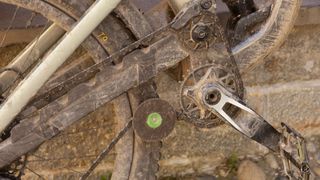
I had to use a homemade roller guide (made from a grinder disc!) while awaiting a replacement, and then had issues with the upper idler stuffing the chain between the jockey and frame. Trek has since made a rolling revision to lengthen the upper idler teeth for better chain stability, but my test bike didn’t have this update. All this faffing was a bit of pain, but didn’t actually stop me riding to be fair, and I’ve since logged thousands of meters descending on the replacement without problems and ended up kind of forgiving the Slash because it’s been so much fun.
Overall, I reckon the Slash offers the security of a big super enduro bike that can handle chunky terrain and is easy to ride fast and in control, while maintaining the sensory stimulation of a ‘regular’ 160mm-ish enduro bike. This much versatility is hard to find and will make the new Slash a solid option for many riders, not just those totally hell-bent on sending the descents.
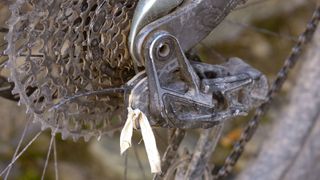
More than just a bike for a downhiller who can’t justify having both a DH and enduro bike, Trek’s Slash 9.9 X0 AXS T-Type Gen 6 is a versatile and efficient all-rounder in its own right. The bike rips downhill and can rub out some serious chunk and the suspension offers continuous support to push into and out of for a really well-balanced rider feel front to rear.
A major highlight is how smooth the bike feels in terms of bump swallowing and vibration damping, without ever losing a sharper edge and enough reactiveness to push on and play harder. Pedaling zip and climbing prowess is decent too, especially for a bike carrying some extra weight due to a high pivot design and added drivetrain parts.
The added complexity of the idler and guide setup caused me some big headaches during testing though, and combined with some underperforming own-brand components, as much as I love the ride quality here, it’s difficult to 100 percent recommend this Slash 9.9 as offering ultimate performance and value.
Test conditions
- Conditions: Every kind of trail and every kind of weather
- Terrain: DH test tracks in San Remo in blazing heat to Bike Park Wales blues in rain via local hand cut enduro tracks and loam
- Temperature: Spring/summer UK weather – 10 to 24 degrees Celsius
Tech specs: Trek Slash 9.9 X0 AXS T-Type Gen 6
- Price: $9,399.00 / £9,400.00 / €9,999.00
- Discipline: Enduro
- Frame: Trek OCLV carbon HP w/internal storage
- Shock: RockShox Vivid Air Ultimate 170mm travel
- Fork: RockShox Zeb Ultimate Charger 3 170mm travel
- Wheels: Bontrager Line Pro 30 carbon w/Rapid Drive 108 hubs
- Tires: Bontrager Team Issue tires 29in x 2.5in front SE6 and 27.5 x 2.5in rear SE5 w/Core Strength sidewalls
- Drivetrain: SRAM XO Eagle Transmission, SRAM XO AXS POD Ultimate, T-Type DUB crank 165mm, XO Eagle rear mech and 10-52t cassette
- Brakes: SRAM Code SLR 4-piston w/ 200mm 6-bolt rotors F&R
- Seatpost: RockShox Reverb AXS 170mm dropper
- Saddle: Bontrager Arvada saddle
- Bars and stem: Bontrager RSL integrated bar stem w/35mm equivalent stem length and 820mm wide bar
- Weight: 16.2kg (35.7lb) M/L tested
- Sizes: M, M/L, L, XL
- Rider Height: 176cm
- Head angle: 63.3 degrees
- Seat angle: 73 degrees
- Effective seat angle: 77.4 degrees
- BB height: 350mm (MX setting)
- Chainstay: 434mm
- Front center: 821mm
- Wheelbase: 1,254mm
- Downtube: 745mm
- Seat tube: 420mm
- Top tube: 606mm
- Reach: 468mm
An ex-elite downhill racer, Mick's been mucking about and occasionally racing mountain bikes for over twenty years. Racing led to photo modelling and testing kit for magazines back in the day, and, nowadays, he's mostly riding enduro-style terrain on conventional and electric bikes. As curious as ever about products and tech, he's as likely to be on the other side of the lens or computer screen rating, reviewing and shooting all the latest gear. Mick's list of regular clients includes Bike Perfect, MBR, MBUK, and most of the leading UK MTB publications at one point or another.
UYN Adventour Cargo bib review – warm weather gravel shorts
I tested the 2.2-liter Oglah hip pack from Wizard Works – but was it a spellbinding experience?
Pro bikes and kit ridden by XCO MTB racers at the Paris Olympic Games that we mere mortals can buy (deep pockets required)
Most Popular
- 2 Is the release of Trek's Slash+ the start of a new trend of enduro bikes with lightweight motors?
- 3 UYN Adventour Cargo bib review – warm weather gravel shorts
- 4 I tested the 2.2-liter Oglah hip pack from Wizard Works – but was it a spellbinding experience?
- 5 Is Privateer's 161 Gen 2 a dependable enduro workhorse that’s ready to race? I took it on an epic month-long Canadian MTB trip with over 67,500m of descending to find out
TREK SLASH 9.9 X0 GEN 6 REVIEW
Words by Drew Rohde | Photos by Staff
After nearly six months of abuse, conversations with Trek Bikes HQ and a YouTube Service Bulletin video full of interesting comments, we’re kicking off the new year with a high pivot, Gen 6 Trek Slash review that should be another great conversation piece as one of the hottest bikes of 2023. We’ve been fans of many of Trek’s bikes over the last few years from the Session DH bike to their Fuel EX and Fuel EXe and of course, the last generation Slash . We first rode the Gen 6 Trek Slash during Crankworx Whistler, where we filmed a Dissected Feature with their engineer: Trek athlete Casey Brown and more. Since then, we spent the rest of summer in the bike park, pedaling backcountry trails and yes, filming a service video on the famous “Chain dropping” issue that commenters had us thinking was affecting nearly everyone who owned one of these bikes. But…as the saying goes, don’t believe everything you hear. Even if you don’t believe what we’ve got to say when it comes to the goods and bads of the new Trek Slash, we think you’ll find it entertaining at least.
QUICK SPECS
• 170mm High Pivot ABP Suspension • Mixed Wheel (29”F/27.5”R) as standard, dual 29” option • HTA 63.3 • STA 76 (effective) • REACH 490 (Large)
FULL BUILD SPEC
CHASSIS Frame: OCLV Mountain Carbon | 170mm Fork: RockShox ZEB Ultimate 170mm | Charger 3 RC2 Shock: RockShox Vivid Ultimate 230x65mm
COCKPIT Brakes: SRAM Code Silver | 200F/R Centreline rotors Bar/Stem: Bontrager RSL Integrated | OCLV Carbon | 820mm | 27.5mm Rise | 35mm Length Headset: Integrated Sealed Bearing Seatpost: RockShox Reverb AXS | S: 100mm, M-XL: 170mm Saddle: Bontrager Arvada
WHEELS Hubs: Bontrager Rapid Drive 108 Rims: Bontrager Line Pro Carbon Front Tire: Bontrager SE6 Team Issue | 29″ x 2.5″ Rear Tire: Bontrager SE5 Team Issue | 27.5″ x 2.5″
DRIVETRAIN Bottom Bracket: SRAM DUB Threaded Cassette: SRAM Eagle XS-1295 | T-Type | 10-52T Cranks: SRAM X0 Eagle | T-Type | 30T | 165mm length Shifter: SRAM AXS POD Ultimate | 12s Derailleur: SRAM X0 Eagle AXS | 12s
Downhill performance is incredible
Rear suspension plush yet solid
Fast and Confident
Bike Park shredder
Vivid Ultimate
WE DON’T
3 Dropped chains (fix appears to work)
Steep, chunky climbing
About The Trek Slash Gen 6
Packing 170mm of travel out back, the new Trek Slash claims to be a 70/30 bike, meaning Trek designed the bike to have a 70% downhill bias with a 30% nod to climbing and uphill capabilities. Needless to say, this isn’t your run of the mill XC or all-mountain bike. It’s designed and built for riders who prioritize downhill speed, composure, and confidence on the gnarliest terrain over efficiency and climbing performance.
Since this review is likely going to get a bit long, we’ll link to our Dissected Feature which has a written interview, all the tech details and a video interview and presentation on the Gen 6 Trek Slash. If you’d like to check that out, click here.
If the CliffsNotes version works for you then we’ll gloss over a few key features:
FRAME AND FEATURES
Updated for 2023, the high pivot Trek Slash Gen 6 can be run with a number of wheel size configurations and can take up to a 190mm travel fork but comes with a 170mm fork and mixed-wheel setup as standard. Riders can choose a full 29er race machine, 27.5” aggro-shredder or put a dual crown 190mm with a mullet and have a mini-Session bike park rig.
With many people loving the last generation Slash, some may have wondered why Trek opted to go to a high pivot and run two idlers? Well, with Trek’s other bikes creeping up in capability and riders wanting to go faster and bigger, it seems many brands are making their bikes bigger and burlier, and of course, more high-pivoty. Trek Slash engineer, Matt Yerke told us that even though the bike’s 70% focused on DH performance, they took time to keep it versatile and pedal-friendly, as a mountain bike should be. Did they deliver? We’ll see down below.
BUILD SPECS AND VALUE
With bikes starting at $4,399 and going up to $11,499, our Slash 9.9 X0 AXS sits on the higher end of the spectrum at $9,399 and comes with a dialed spec. If we were spending our own money however, we’d likely be checking out the Slash 9 or Slash 9.8 XT models.
Chain Drop Service Bulletin and Notes from Trek
We published this How To Video to address some of the popularized videos and comments talking about chain drop on the new Trek Slash. After publishing this video and seeing all the comments, we reached out to Trek as it had us reconsidering our official stance on the long-term review you’re about to see below. The statement below from Trek, which we are taking as truthful, made us feel better and also aligned with our notions of what we’ve observed. Trek passed our concern around their Customer and Dealer Service teams and below is a small excerpt.
“First off, Trek Bicycles and I would like to acknowledge that it is frustrating to buy a nice new bike that doesn’t work exactly like it should out of the box. Luckily however, it has been a very small number of people affected and thankfully they have been far less upset than what online commenters may have you believe.
Trek’s customer service team has actually received way more calls about internet comments talking about chain drop than actual Slash owners who are experiencing the issue. We have found that a handful of riders said the fix did not entirely solve their dropping issues. We have sent out early units of our updated idler wheel to that handful of riders, one of which is Ryan Howard, who has been spending a ton of time on his Slash. We’ve been pleased to hear that those riders are no longer having any drop issues.
These will ship to dealers at no cost for any Slash owners who want to get one.” – Ross Rushin // MTB Product Manager
When evaluating the new Gen 6 Trek Slash 9.9 X0 AXS against the previous generation Slash and current offerings from other brands in this genre, the Slash commands attention. As with any purpose-built product, the things that make it excel can also alienate or turn off others. I’m traditionally not a huge fan of high pivot bikes, though I’ve grown to like mid-high pivot bikes for certain applications. Rocky Mountain’s Powerplay eBike and the Trek Session , which we reviewed last year, are two examples of mid-high pivot bikes that I like quite a bit.
Chances are you’ve already heard the touted claims of high pivot bikes since they’ve been so heavily marketed over the last couple of years, so we’ll save you the pitch. What is undeniable though, is that they can charge over terrain and obstacles a bit better than other designs, but only if they are tuned and designed well. We have ridden some high pivots that don’t really improve much, but suffer the downsides of a high pivot, but we’re happy to report that Trek has avoided this ill fate.
SETUP | Setting up The Trek Slash was one of the easier tasks of the year. It required almost zero tuning, customization or tinkering with to feel amazing. If you’ve read our older Trek reviews, you may recall us being a bit critical about the tune being a bit too mellow, which led to heavier or more aggressive riders needing to add maximum volume reducers or going our route, contacting Fox Shox to weasel a Trek Factory Racing tuned shock, which did wonders for the bike. This is no longer an issue as Trek seem to have finally identified that if they’re going to design an aggressive bike for aggressive riders, they need to have a shock and tune that are ready for it.
The most time-consuming part of our review bike’s set up was removing the one-piece Bontrager bar and stem combo unit and replacing it with our favorite OneUp Components Ebar and stem. This resulted in a better body position and way less hand fatigue.
DESCENDING | Trek has done a great job of making the new Slash’s suspension absolutely devour hits of all sizes. The RockShox Vivid Ultimate rear shock only compliments the insane capability of the Slash’s rear end. It is possibly the smoothest, best feeling rear suspension I’ve felt in a while. For me, a rider who loves smashing, gapping and floating rough, chunky downhill trails, it offers a very nice platform for support and control, but gets out of the way offering a bottomless and smooth feel. I could have been tricked into thinking a coil shock was mounted out back based on the composure and smoothness.
When it comes to downhill performance, the Trek Slash may be the best descending mountain bike we rode in 2023! It absolutely shreds trails with ease and begs to go faster. Whether we were lapping blown-out end of season bike park trails or remote backcountry downhills, the Slash leads the way. In fact, we can’t think of any bikes that aren’t downhill bikes that we’d want to ride in a bike park more than the Slash. The speed this bike carries, composure over braking bumps, big and little hits as well as the way it corners make it a really impressive machine.
The downside is, the compliance combined with the weight, makes this bike a little bit tougher to jib on smaller features at slower speeds. It absolutely still gets off the ground and is fun to play on, it just requires a bit more muscle to get it up and tweaked. Granted, this rocket ship wasn’t designed with lower speeds in mind, and it shows with a list of Personal Records that our various testers achieved.
Another downside is that the bike does have more stuff to go wrong. Whether you’re one of the unlucky riders dropping chains – which we did three times before the service bulletin addressed the issue – or not, more moving parts, extra chain links, and more nooks and crannies all mean more chances for things to go wrong.
CLIMBING | Along with the above concerns, the climbing performance of the Gen 6 Slash certainly isn’t what its outgoing sibling offered. Since taking possession of the Trek Slash 9.9 XO AXS we’ve had four riders put time on it. Two of which owned previous generation Trek Slashes. All riders agreed, like Trek claims, this bike is a definite 70/30 bike, and the climbing performance is tolerable in certain situations like fire roads and smoother trails, but can be a struggle on more steep, technical trails with larger obstacles that want to eat your momentum.
The weight is noted, and while the drag may be a claimed 3%, it felt a bit closer to 10% in practice. That could be exacerbated by the lengthening rear end – yes, the same thing that makes high pivots so great, also works against it.
It’s been a while since we graduated but, we think someone smart once said something about actions having reactions, but we didn’t pay close attention in school so maybe we’re making it up. Either way, when speeds are low, the grade steep and effort high, we found that the rear end could “stall” as we tried to pedal over roots or rocks, sucking our energy and momentum in the process. Much the way the rear end grows to get up and out of the way of an impact while descending, as you climb and hit an obstacle, the front continues to creep up the hill as you grind away at the pedals. However, the rear wheel goes backwards before going up and that delay can make it feel like you’re pedaling harder to get up and over that obstacle, which means more energy and slower times. Of course, this bike wasn’t designed to race up the hill, it’s meant to go down. If your energy is spent on the way up, however, it could be worth considering you may be more fatigued when that race timer starts.
FINISH AND VALUE | Now, as amazing as the bike is, we did in fact drop the chain three times over the six-month test period we had. Since the repair, we didn’t drop the chain, however we only had a few rides on it before winter hit, so we can’t say with 100% confidence it’s gone, but we are pretty certain that with the updated spacing and especially the new idler wheel, we’d be in good shape. You may want to wait until the updated idlers hit, hopefully February of 2024, but in the meantime the chain dropping issue may not be quite as bad as commenters may have you believing.
The rest of the bike is a nicely put together package. Trek paint had some years known for being a bit, soft we’ll call it, and while it’s still not as durable as we’d like, it’s a lot better. Though we’d recommend a frame wrap, of course, we’d recommend that on any bike, so maybe not a surprise there. If you stop, look closely and examine the details of this bike, it does look very nice, has quality bits, nice hardware and a very classy overall appearance. Trek have done a nice job making this a drool-inducing bike.
The Wolf’s Last Word
Price: $9,399 Weight: 36.4lbs Website: Trekbikes.com
LEAVE A COMMENT, WIN FREE SWAG!
Want to win some free schwag? Leave a comment and vote up the most thoughtful comments and each month we’ll pick a winner. The person with the smartest and most helpful replies will earn some sweet new gear. Join the Pack and get the latest news and read the latest reviews on the top mountain and electric mountain bikes .
2024 Trek Slash
Wheel Size:
- Size Small: 27.5’’
- Sizes Medium through XL: 29’’ front / 27.5’’ rear (29’’ compatible)
Travel: 170 mm rear / 170 mm front
Geometry Highlights:
- Sizes offered: S, M, M/L, L, XL
- Headtube angle: 63.3° (Default setting, adjustable)
- Seat tube angle: ~77° (Varies by size and geometry setting)
- Reach: 488 mm (size Large)
- Chainstay length: 434 mm (size Large)
Frame Material: Aluminum and carbon fiber versions available
Price: Complete bikes: $4,400 to $11,500
Blister’s Measured Weight: 36.6 lb / 16.6 kg (Slash 9.8 GX, Large)
Reviewer: 6′, 170 lb / 183 cm, 77.1 kg
Test Duration: 3.5 months
Test Locations: Washington, British Columbia
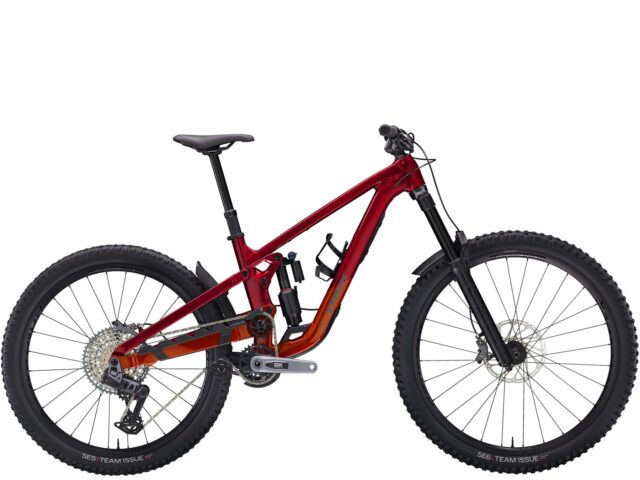
The Slash has been a longstanding part of Trek’s lineup — dating back to the days of 26’’ wheels — as their long-travel Trail model and eventually their Enduro race bike once that category emerged.
The fifth-generation Slash debuted a little over three years ago now, so it isn’t a big surprise that a new version has now surfaced. However, some of the new design details suggest it’s a more substantial update than simply “half a degree slacker here, a few millimeters longer there.”
The prior-generation Slash was arguably a touch conservative in some aspects of its design and geometry even back when it launched, but you’d be hard-pressed to say the same about the new sixth-generation bike — it’s gotten a big overhaul in just about every facet, and there’s a lot of interesting stuff going on here.
The Slash is now a 170mm-travel bike with a high-pivot layout — clear indications that it’s meant to be a big, gravity-oriented bike. But Trek makes it clear that they mean for the Slash to pedal well and climb efficiently, and say it’s intended to be confidence-inspiring for all sorts of riders on rugged descents, not a super game-on bike for only the hardest chargers out there. But what has Trek done to make that happen? Let’s check out the new Slash.
[And for a bunch more on the new Slash, including its design goals and how Trek went about achieving them, check out Ep.186 of our Bikes & Big Ideas Podcast with the lead engineer on the project, Matt Yerke.]

Like the fifth-generation Slash, the sixth-gen one is offered in your choice of an aluminum or carbon fiber frame, in sizes ranging from Small through XL with an ML snuck in the middle. It uses Trek’s longstanding ABP suspension layout — essentially a linkage-driven single pivot with a pivot between the chainstay and seatstay that’s located concentric to the dropout, to give a floating brake mount akin to a Horst link bike.
The big visual change is that the suspension layout has been reconfigured to feature a much higher main pivot, necessitating the use of an idler pulley to reign in the interaction between the rear suspension and chain forces, both in terms of anti-squat and pedal kickback. That idler pulley is on the larger side for high-pivot bikes (19 teeth) and is mounted to the chainstay substantially offset from the main pivot. This is in contrast to Trek’s Session DH bike, which mounts its idler concentric to the main pivot; that said, some of Trek’s athletes have been spotted riding what looks to be a prototype chainstay on the Session that moves the idler to a more Slash-like spot below and behind the main pivot.

Trek co-developed a lower chain guide specifically for high-pivot bikes, in collaboration with MRP, in order to increase chain wrap around the chainring, improve chain retention, and mitigate derailleur clutch movement (and in doing so, improve small-bump sensitivity from the suspension). That guide actually came out a while ago as the “MXg” and is designed specifically for high-pivot bikes such as the Slash. It includes an integrated bash guard and features a larger-than-average 14-tooth roller to reduce how much the chain has to flex, thereby keeping drivetrain drag to a minimum. It bolts to the lower two mounts of a set of ISCG-05 tabs (the Slash includes all three, though it’s not compatible with conventional upper chain guides due to the idler pulley); an integrated upper guide over the idler is included. The Slash is designed around a 55 mm chainline crank (as featured on SRAM’s new Transmission groupsets ) and uses a threaded bottom bracket shell. Despite the extra pair of pulleys, the Slash takes a standard 126-link chain in all sizes apart from the XL (which needs 128 links, due to its longer chainstays — more on those below).
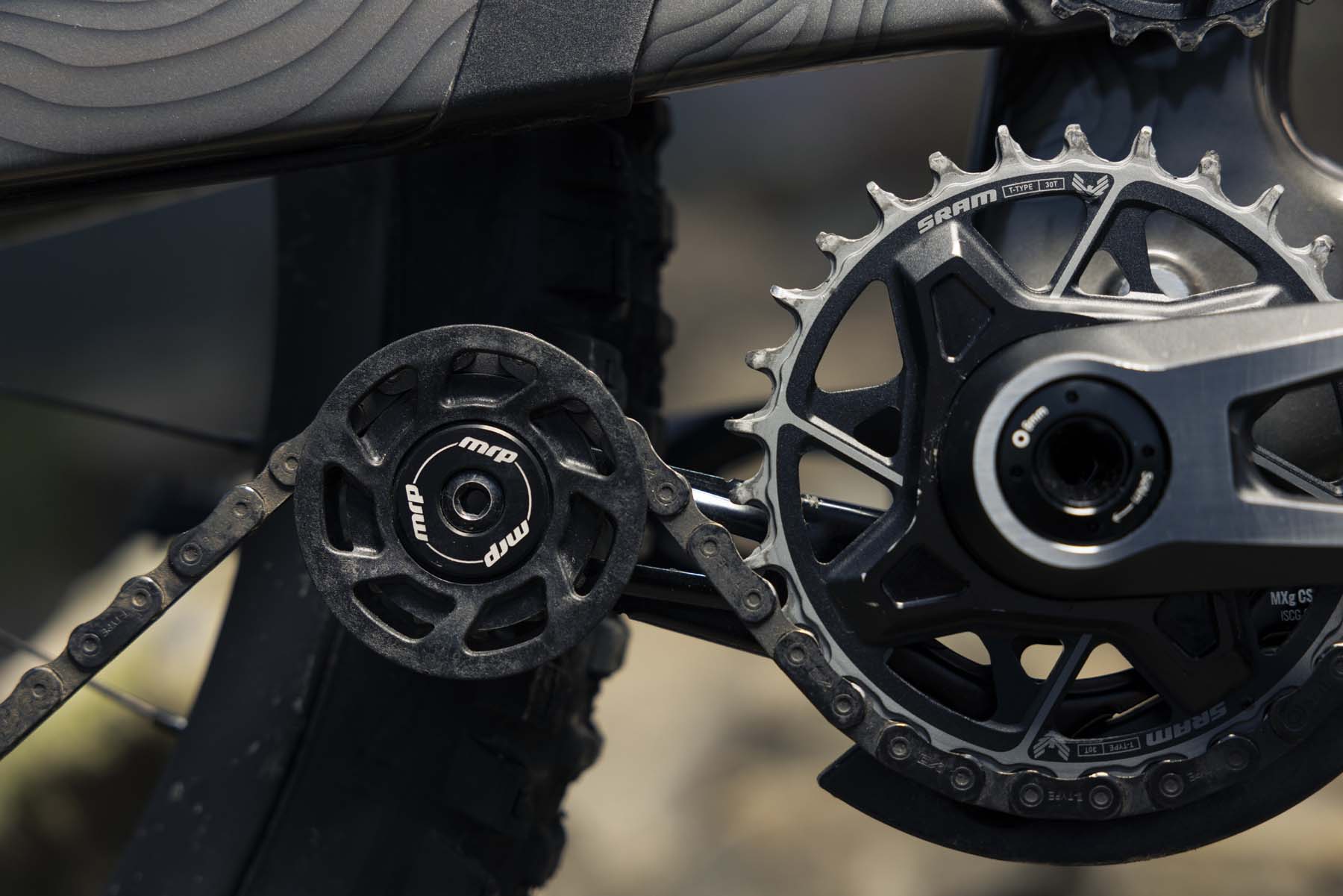
[It’s not labeled in this graph, but Trek says that the published numbers are in a 30/21 gear ratio, with the center of gravity sitting 800 mm above the bottom bracket.]
A flip chip in the sixth-gen Slash’s lower shock mount toggles between two different leverage curve settings, producing either ~20% or ~25% of progression in generally straight lines. A 230 x 65 mm shock produces 170 mm of rear wheel travel and the funky through-shaft shock used on the prior-generation Slash is no more, replaced by a standard RockShox Vivid on most of the complete builds (more on those below). Air shocks are spec’d throughout, but Trek says coils work just fine, too.
Speaking of the lower shock mount, it’s a bolt-on part that can be swapped to toggle between a 27.5’’ and 29’’ rear wheel on the size Medium through XL frames, paired with a 29’’ front wheel. The Small frame gets 27.5’’ wheels at both ends to keep the stack height in check for shorter folks. Interestingly, all the builds and sizes (Small excepted) come in the mixed-wheel configuration, only, with the 29’’ shock mounts sold separately for folks who want to make that conversion.
To round out the frame adjustability, Trek also offers offset angle-adjusting headset cups to toggle between three different headtube angle settings, as previously seen on the Fuel EX and Fuel EXe Al. Bikes ship with the neutral cups installed; the offset ones are available separately. The upper cup is a drop-in installation, but the lower one is a press-in affair.
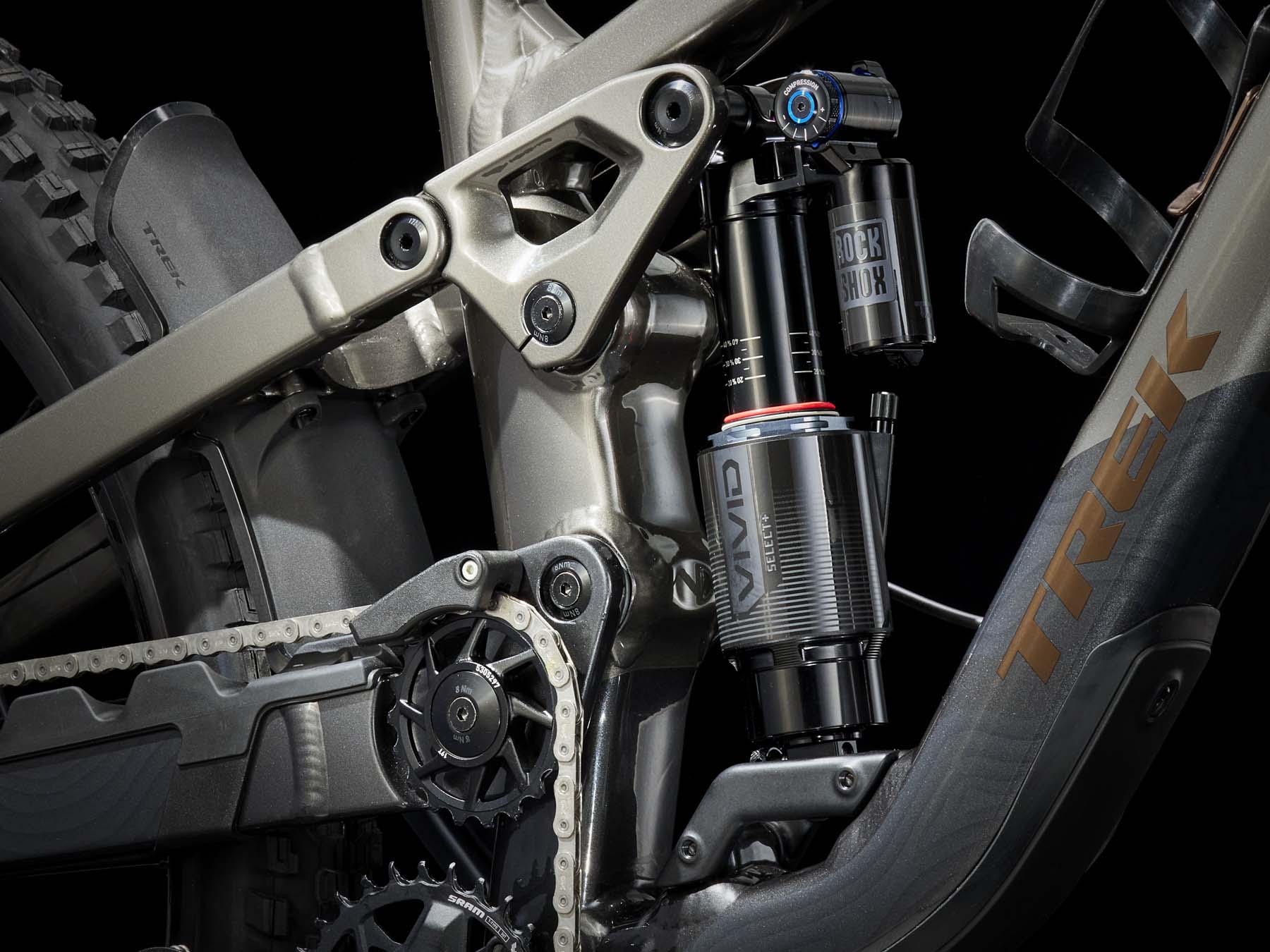
Trek was one of the first companies to offer in-frame storage on mountain bikes, and the new Slash continues the trend with a hatch under the water bottle mount on all frame sizes, in both the aluminum and carbon fiber frames. Cable routing is fully internal, with ports for the rear brake on both sides of the head tube, for folks who run their rear brake on the left side. The Slash features ample rubber guards on the chainstay, seatstay, and downtube, with the downtube guards bolting on for easy replacement should they get damaged. Trek says they’ve also applied a layer of an impact-resistant film underneath the paint on the carbon frames to further protect the frame from damage. A bolt-on rear fender is included as well, though Trek says it’s only compatible with a 27.5’’ rear wheel — there’s not enough clearance with a 29’’ one.
Trek specs the Slash with a 170mm-travel fork, but says that a single-crown fork up to 190 mm travel can be used if you want to go that route. Dual-crown forks, on the other hand, aren’t currently approved, though Trek says that they simply haven’t tested them enough to say for sure either way, so it’s possible they’ll be condoned at some point in the future. Trek has also done away with the Knock Block steering-limiting headset on the new Slash, and single-crown forks easily clear the downtube.
Fit & Geometry
Trek offers the Slash in five sizes, Small, Medium, ML, Large, and XL, with the reach ranging from 430 mm to 508 mm in roughly 20 mm increments. The headtube angle is 63.3° for the Medium frames on up (the Small steepens very fractionally to 63.5°). The effective seat tube angle is around 77° (varies slightly by size), with a still-pretty-steep 74° actual angle for the whole size range. There’s no kink in the seat tube on the new Slash, so dropper post insertion has been greatly improved — Trek says you can bottom a 200 mm post to the collar on a Medium frame. The chainstay lengths now vary by size, with the Small starting at 429 mm and the XL topping out at 439 mm; the Medium comes in at 429 mm, and the ML and Large share 434 mm stays.
All of those numbers are in the stock geometry configuration (i.e., neutral headset cup, mixed wheel sizes on Medium and larger sizes, dual-27.5’’ wheels on the Small). Going to a full 29’’ configuration on the sizes that support it steepens the headtube and seat tube by 0.2°, adds almost 6 mm to the chainstay length, and increases the reach by a couple of millimeters. Installing the offset headset cups either steepens the headtube angle by 0.8° or slackens it by 0.7° with fractional changes to the other geometry numbers.

[There’s a typo in Trek’s listed geometry charts, above — the reach on the XL frame in the mullet configuration should be 508.1 mm. And for the full range of charts, including with the offset headset options, check out Trek’s website.]
Those are really nice-looking numbers for a modern Enduro bike. If anything stands out as being a little bit unusual, it’s the fairly short chainstay lengths in the 27.5’’ rear-wheel settings. That said, it’s worth bearing in mind that the high-pivot layout and notably rearward axle path that it produces means that the Slash’s stays are substantially longer at sag, and continue to grow as it cycles deeper into the travel. That’s also why the chainstay length changes so much between the 27.5’’ and 29’’ rear-wheel configurations, and it’ll be interesting to see just how much the different rear-wheel options impact the ride of the Slash. We’ve got a set of the optional 29’’ rear wheel shock mounts for our test bike and will be finding out.
Trek offers the Slash in seven complete builds, with pricing ranging from $4,400 to $11,500. There’s a mix of SRAM and Shimano drivetrains in here, but apart from the entry-level Slash 8, all builds get some variant of a RockShox Vivid shock and ZEB fork (with the exact version varying by build tier). As per usual for Trek, builds with a whole number indicate aluminum frames, and “9.X” denotes a carbon one.

- Drivetrain: Shimano XT w/ Deore crank and SLX chain
- Brakes: Shimano Deore 4-piston
- Fork: Fox 36 Rhythm
- Shock: Fox Float X Performance
- Wheels: Bontrager Line Comp 30
- Dropper Post: Bontrager Line
- Drivetrain: SRAM GX Transmission
- Brakes: SRAM Code Bronze Stealth
- Fork: RockShox ZEB Select+
- Shock: RockShox Vivid Select+
- Drivetrain: Shimano XT
- Brakes: Shimano XT 4-piston
- Wheels: Bontrager Line Elite 30 Carbon
- Dropper Post: Bontrager Line Elite
- Drivetrain: SRAM X0 Transmission
- Brakes: SRAM Code Silver Stealth
- Fork: RockShox ZEB Ultimate
- Shock: RockShox Vivid Ultimate
- Wheels: Bontrager Line Pro 30 Carbon
- Dropper Post: RockShox Reverb AXS
- Drivetrain: Shimano XTR w/ e*thirteen LG1 Carbon crank
- Brakes: Shimano XTR 4-piston
- Drivetrain: SRAM XX Transmission
- Brakes: SRAM Code Ultimate Stealth
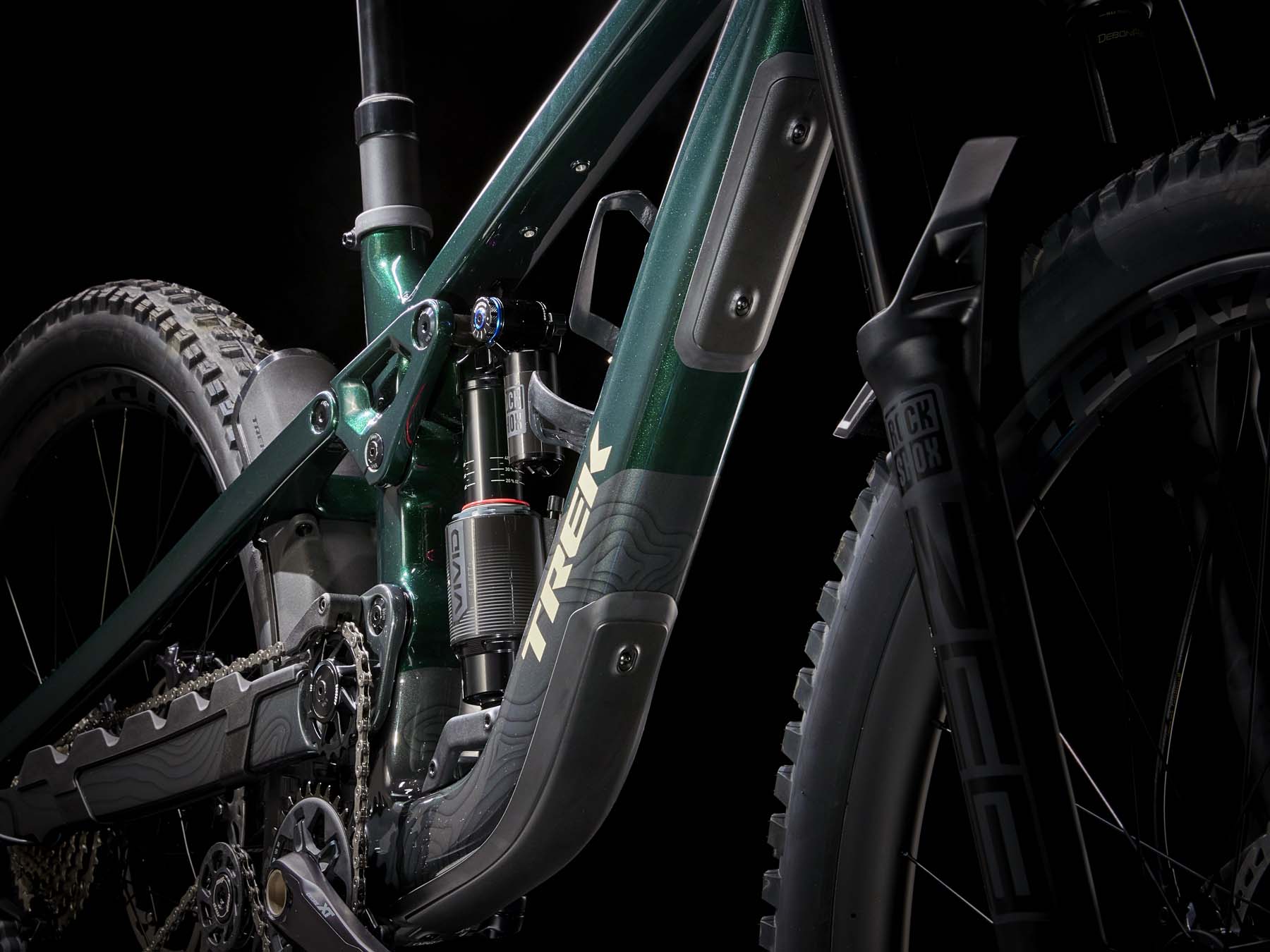
Some Questions / Things We’re Curious About
(1) The new Slash clearly looks to be a true, modern Enduro bike, with geometry and suspension numbers that should make it quite stable and composed at speed. But how versatile is the Slash, and how well does it pedal? Is it an ultra-planted sled of bike (a-la the Norco Range) or is it more well-rounded than that?
(2) How does the Slash stack up against many of the other high-pivot Enduro bikes that have been flooding the market of late, including the Norco Range , Forbidden Dreadnought , Nicolai Nucleon 16 , Cannondale Jekyll , Kavenz VHP 16 , Contra MC , and more?
Bottom Line (For Now)
Trek’s first high-pivot non-DH bike has been a long time in the making — check out Ep. 186 of Bikes & Big Ideas for a lot more on that, including how Trek considered making the Fuel EX a high-pivot. But it’s finally here, and the new Slash looks to be a compelling take on the genre. We’ve already been spending a lot of time on the Slash and will be logging a lot more miles on it in the months to come — stay tuned for our full review.
Flash Review
Blister Members can read our Flash Review of the Trek Slash for our initial on-trail impressions. Become a Blister Member now to check out this and all of our Flash Reviews , plus get exclusive deals and discounts on gear, and personalized gear recommendations from us.
FULL REVIEW
On paper, the new Trek Slash looks like one of the more emphatically descending-oriented Enduro bikes out there, with 170 mm of travel at both ends and a high-pivot layout derived from their Session DH bike .
We’ve been spending a lot of the summer and fall on the new Slash, and it is indeed very stable, composed, and confidence-inspiring when going very fast on steep, rough trails. But is it just a big bruiser of a bike, or is it more versatile than its numbers might suggest? And how does it stack up against a bunch of the other Enduro bikes out there? The answers are pretty interesting.
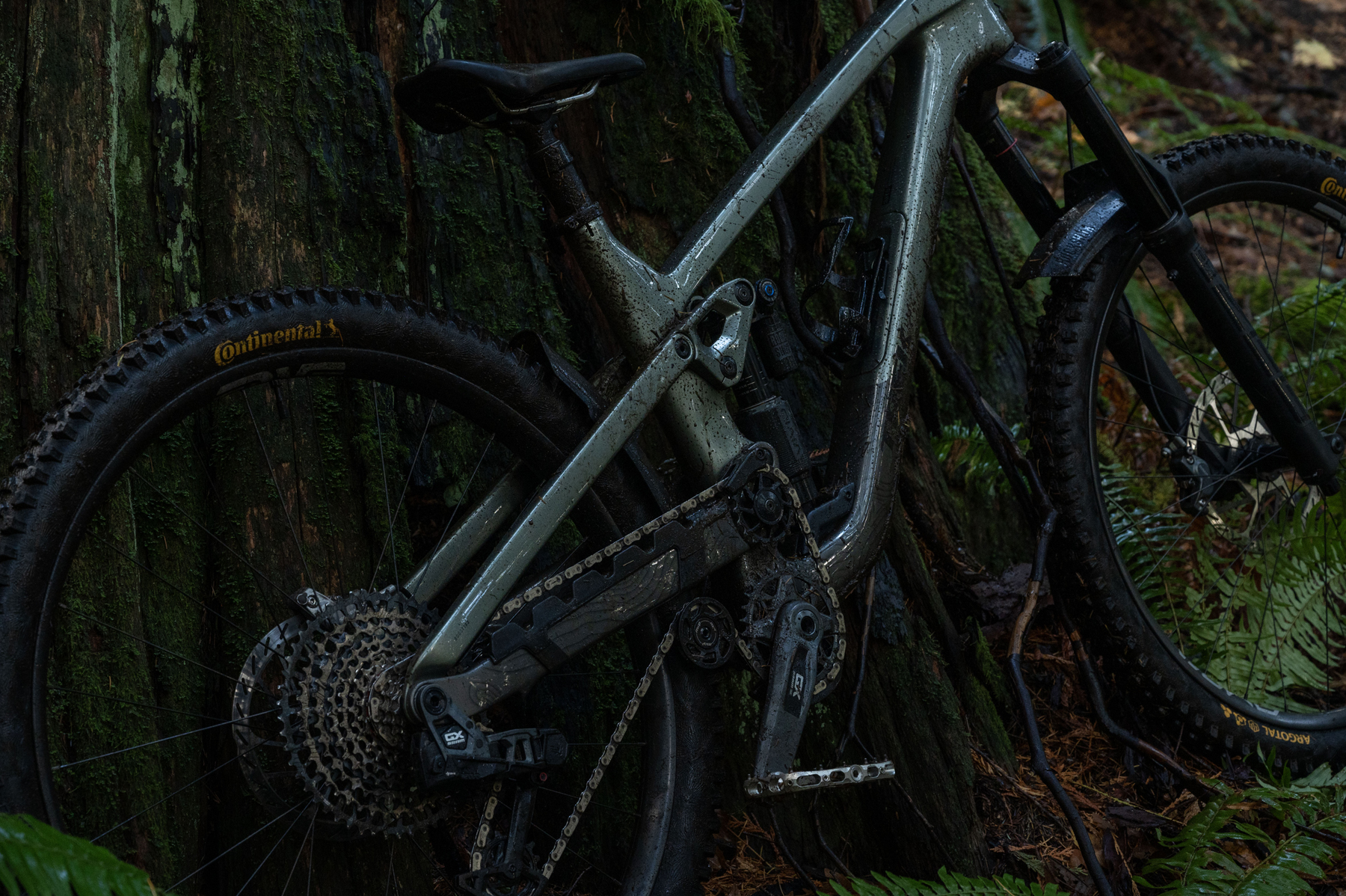
Fit & Sizing
Trek’s recommended sizing for the Slash puts me (6’ / 183 cm) squarely in the middle of the sizing band for the Large frame and outside of the overlapping regions for the M/L and XL sizes. That feels pretty on the money — I had an easy time getting comfortable on the Large Slash and wasn’t ever tempted to deviate from that size. If I were to make any changes to the Slash’s fit I might be tempted to bump up the stack height a little bit. Fortunately, the fork’s steerer tube came cut long enough to allow a hefty stack of spacers, and I wound up swapping out the stock bar for ride-quality reasons anyway (more on that in a minute); a 30 mm rise one suited me nicely.
The Slash’s seat tube is fairly steep (about 77° effective / 74° actual) and the pedaling position feels moderately compact relative to the roomy ~490 mm reach — pretty typical for a modern Enduro bike, but not to the point of feeling awkward on flatter climbs or anything like that.
I honestly don’t have a ton to say here — the Slash fits and feels pretty normal for a modern Enduro bike, and I mean that as a compliment. I had an easy time getting comfortable on it, without anything quirky or surprising going on. And given its relatively small 20 mm steps in reach between sizes, most folks should be able to find a size that works for them.
The Slash is a long-travel high-pivot bike, and even with its carbon fiber frame, carbon wheels, and not-super-heavy tires, our size Large Slash 9.8 GX review bike weighs in at 36.6 lb / 16.6 kg without pedals. Given that, I didn’t have the highest expectations for the Slash’s climbing performance when I first threw a leg over it, but it easily cleared the low bar I’d set in my head — the Slash pedals quite well for what it is. As is the case with pretty much every other ~170mm-travel Enduro bike out there, the Slash isn’t particularly interested in climbing quickly, relative to most shorter-travel “Trail” bikes, but if you’re okay with taking things a little easier and spinning (rather than sprinting) your way to the top, the Slash is impressively efficient.
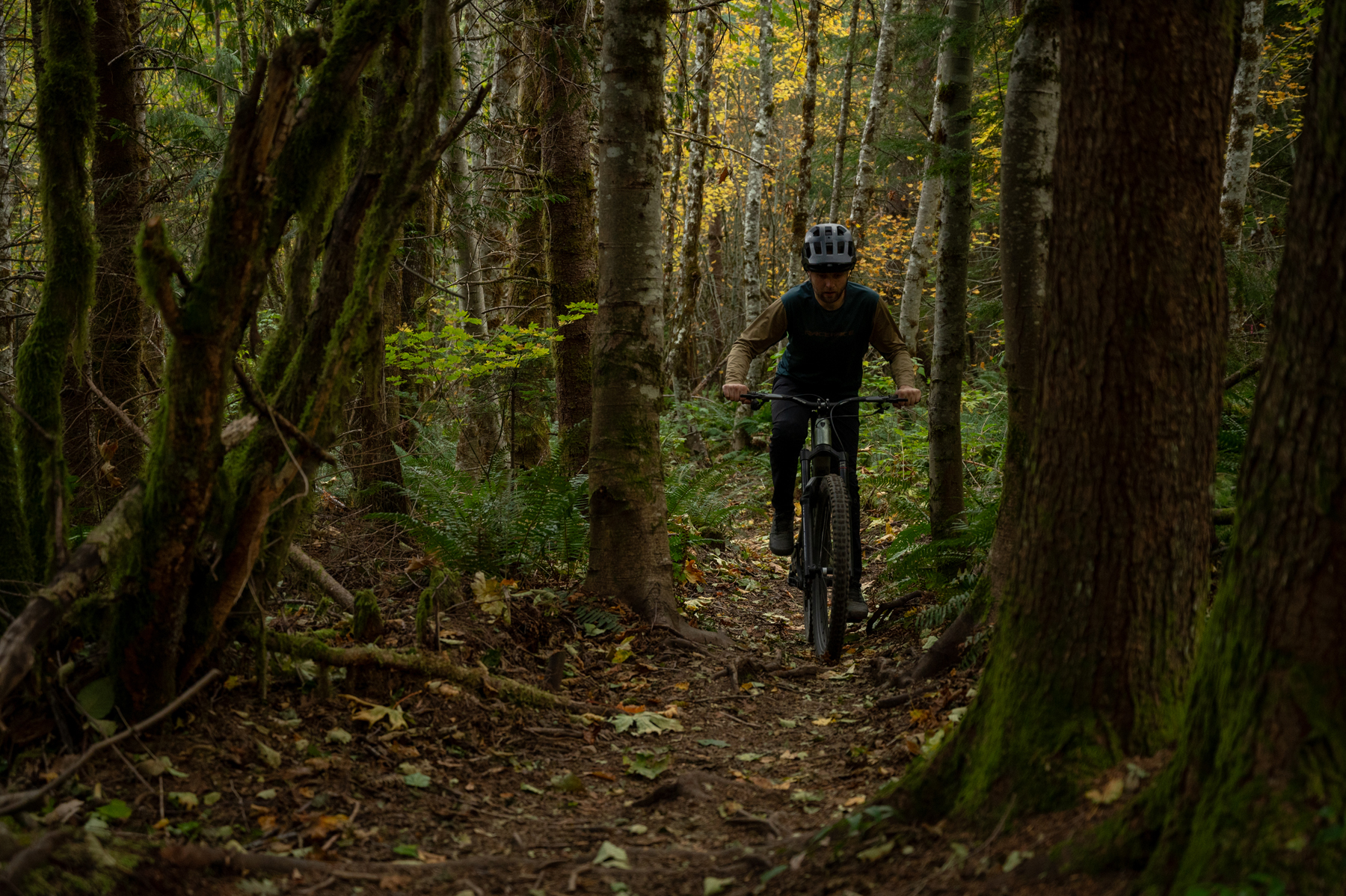
Even with the shock’s climb switch open, there’s not a ton of suspension movement under power, so long as you keep your pedal stroke reasonably smooth. The quite-firm climb switch on the RockShox Vivid adds a very solid platform if you want it. I found myself mostly not bothering with the climb switch very often — the Slash genuinely pedals quite well without it, and I found the loss of traction and comfort to rarely be worth the modest increase in efficiency. That said, I like the combination of a bike that doesn’t need a climb switch and a shock with a notably firm climb setting for the times you really want to eke out every bit of efficiency. I’m a big fan of how the Slash pedals.
As per usual for high-pivot bikes, the Slash does feel like its drivetrain efficiency falls off more quickly as the chain gets dirty and poorly lubed, relative to most bikes with a more conventional drivetrain layout. But provided that the chain isn’t too horrendously gritty and/or dry, the added drag from the extra couple of pulleys on the Slash feels modest. Straight out of the box, there was a bit of noticeable extra noise from the main idler pulley under pedaling, but that quieted down after a ride or two as things wore in, and the overall amount of drag from the Slash’s drivetrain feels very manageable.
The Slash is also a pretty good technical climber, especially from the standpoint of combining solid pedaling efficiency with very good rear-wheel traction under power. As is generally the case with long, low, slack bikes, the Slash can feel like a lot of bike to maneuver through rough, tight, ledge-y sorts of climbs, but it doesn’t feel unduly tough to manage in those circumstances — it just is a long, slack bike, and the tradeoffs there are typical of bikes with geometry numbers like that of the Slash. When things get really tight and awkward, a shorter-travel, more nimble bike is going to be easier to manage, but for the sorts of climbs where the main challenge is simply maintaining rear-wheel traction and keeping momentum, the Slash does quite well.

Especially in the stock mixed-wheel-size configuration, I did find myself wanting a bigger chainring than the stock 30-tooth one — the 30 x 52 low gear combination, paired with a 27.5’’ rear wheel, felt too low to be useful in most circumstances, and on some of the steeper climbs around here, I found myself wanting a gear between first and second. It would, of course, be an easy fix to swap in a larger chainring if you end up feeling similarly, though I (at least partially) solved the issue by swapping in a 29’’ rear wheel for much of my time on the Slash — a setup that I wound up personally preferring mostly for handling reasons, as I’ll describe in more detail below.
While the Slash does a commendable job of getting to the top under human power, it’s a bike that’s meant for the trip back down. So:
The Slash is, unsurprisingly, quite composed and confidence-inspiring when it comes to riding steep, technical trails at speed. It’s stable and planted without being so glued to the ground that it’s all that difficult to “get light” on and skip over holes and rougher bits. It also carries speed quite well when given enough pitch and space to let the bike run a bit. None of that should come as a surprise for a 170mm-travel high-pivot bike. However, the Slash does an especially good job of doing all that smash-y big-bike stuff while also being impressively intuitive and comparatively manageable in slower, tighter spots and/or when you’re taking things easier.
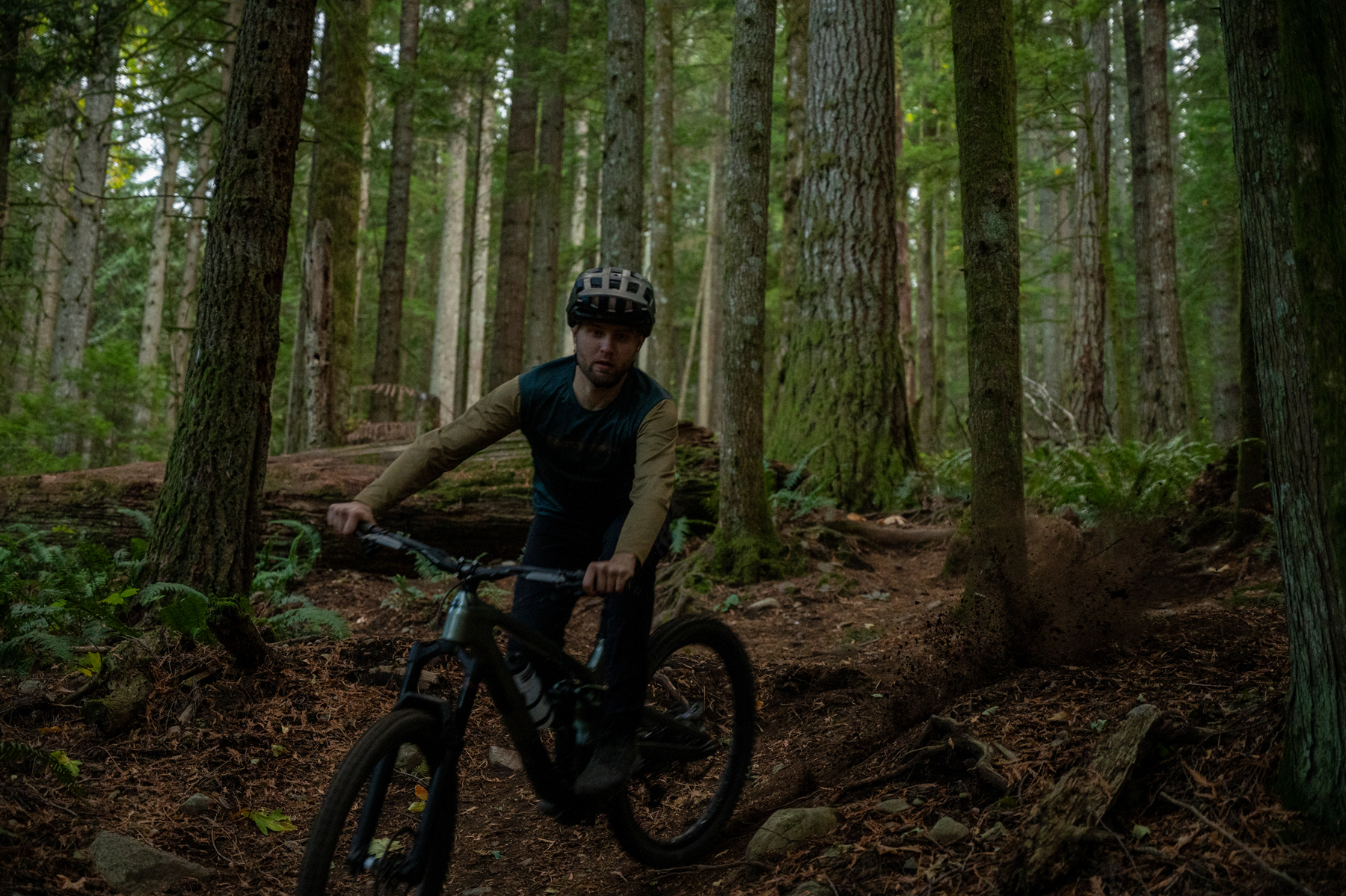
Of course, that’s all relative — the Slash is a long, slack, bike, and it’s not going to trick you into thinking you’re on a much more nimble, shorter-travel one when things get tight and awkward. But the Slash is very consistent and predictable, and that goes a long way toward making it easy to manage in a wide range of situations. The Slash’s braking performance is quite neutral, and it doesn’t have the same kinds of handling quirks that some bikes with ultra-rearward axle paths can display as the rear center (and therefore the balance point on the bike) changes wildly though the travel (e.g., the Forbidden Dreadnought ). The Slash is generally just very, very intuitive in both its handling and suspension performance.
Not needing to translate and react to what the bike is doing simply makes the Slash easy to get on and go, whether you’re flat-out charging or just want to have an easier time while riding steep, difficult trails. As with pretty much every bike in this sort of travel range, I wouldn’t recommend the Slash if you’re not going to be taking it down steep, technical descents on the regular. But for what it is, the Slash is pretty versatile, both in terms of the sorts of riders who I can see getting along with it, and in that feels more manageable than a lot of other similarly composed, stable bikes when you’re not going flat out.
The Slash also does a relatively good job of still being able to maintain speed by pumping — not a strong suit of high-pivot bikes in general — and otherwise facilitating a more dynamic, active riding style for being as stable and composed as it is when you just want to let the bike plow. That “relatively” is important — we’re talking about a big, very stable bike after all, and if you’re after a truly lively, energetic ride, you’d be better off with something lighter, shorter-travel, and more compact. But the Slash is impressively well-rounded for what it is.
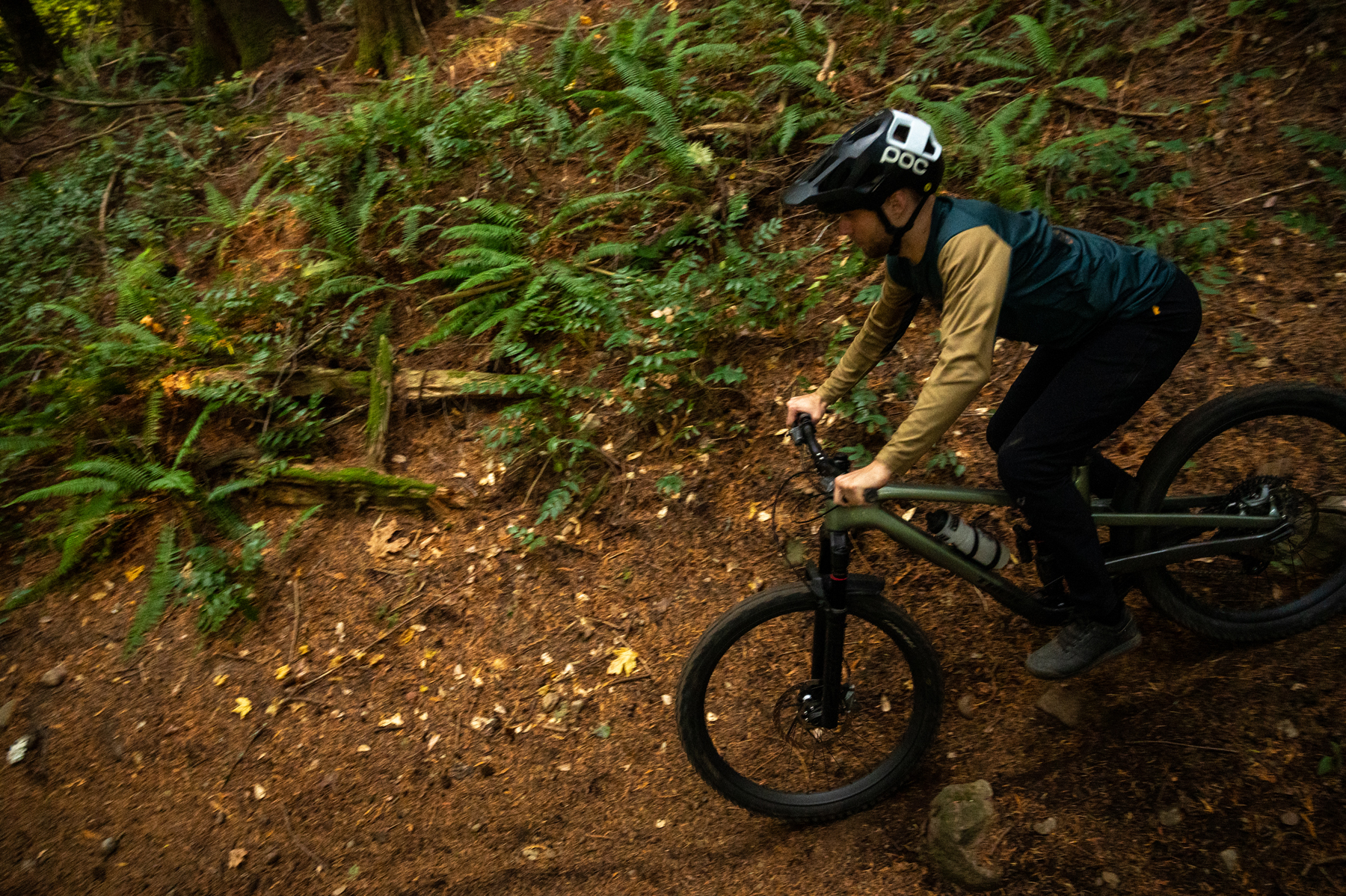
The fact that the Slash doesn’t feel exceptionally glued to the ground and eager to iron out every little bump probably helps in that regard. When you start going faster and hitting things harder, it is quite composed and confidence-inspiring in how it deals with bigger impacts and compressions, but isn’t exceptionally plush and cushy feeling on smaller chatter. It does a good job of maintaining traction on off-camber roots and the like, but does still transmit a bit of feedback about what the wheels are doing. Some bikes (e.g., the Norco Range ) iron out every bit of trail chatter more completely than the Slash. However, those bikes also tend to feel “dead,” less rewarding and energetic when loading them up to pop off something, and/or lack support through the middle part of the travel. The Slash hits a really nice middle ground there.
On that note, I found myself preferring the more progressive of the Slash’s two linkage settings; it offered improved bottom-out control and support deeper in the travel, especially when carrying speed into a really rough section of trail, where the lower progression setting felt slightly more prone to settling deeper in the travel and feeling slightly less balanced in how the bike used its front and rear travel. It’s not a stark difference by any stretch, and the lower progression setting feels plenty useable, especially for folks who want to make the Slash a little more supportive and lively in the beginning part of its travel. It’s easy to toggle back and forth, especially if you also loosen the two bolts that fasten the lower shock mount plates a turn to make aligning the shock hardware easier, and is worth experimenting with if you’re curious.
Wheel Sizes
Toggling between the Slash’s stock mullet wheel configuration and the optional full-29er setup doesn’t make for a massive change in the Slash’s character, either, but offers a relatively subtle twist on the same overall recipe in roughly the ways you’d expect. The smaller 27.5’’ rear wheel option makes the Slash a little quicker handling and correspondingly not quite as stable at speed, but I’d say the bigger difference is that it moves the Slash’s preferred balance point forward and biases it more toward being ridden with weight over the front wheel — bear in mind that the mixed-wheel configuration also shortens the chainstays considerably. The mixed-wheel setup also makes the back end quicker and easier to come around if you keep the front end weighted. The more you want to, well, slash and drift turns, the more the mullet configuration is likely to make sense; the 29er setup makes the Slash’s sweet spot feel bigger, especially if you’re riding it more centered and loading up the bike through the pedals in corners.
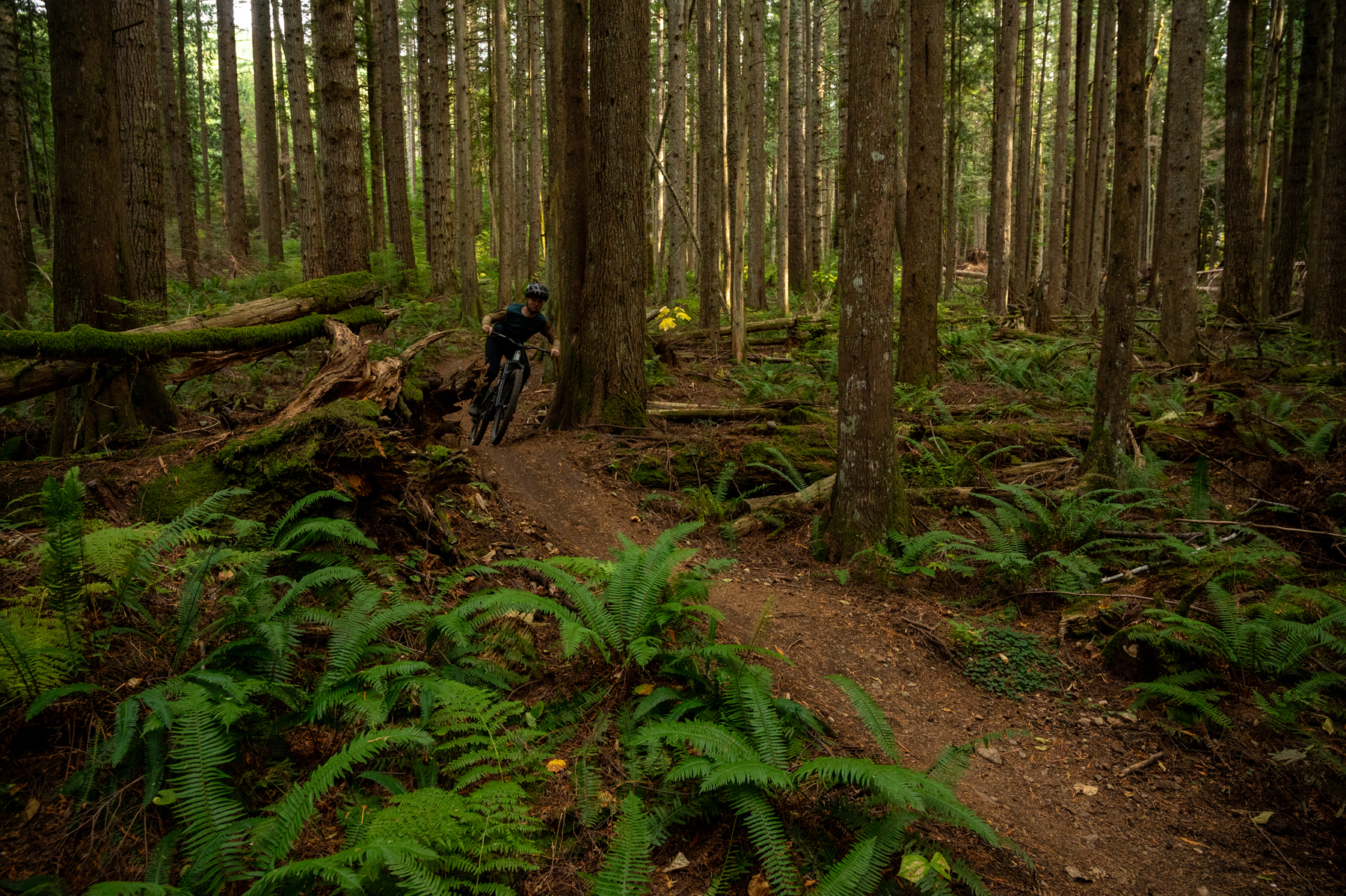
I found myself preferring the matched 29’’ wheels for that reason — they just give me a bigger platform to move around on the bike without upsetting its weight distribution between the wheels. As a result, they made it easier for me to push hard at speed. The mixed-wheel setup was more fun on trails where the Slash was borderline overkill and arguably makes it a little more versatile overall.
Still, the Slash is a big, descending-oriented bike that just happens to be a little more versatile than many other bikes that are similarly composed at speed in rough terrain, rather than a truly versatile all-rounder, so I found myself preferring to lean into what the Slash does best and emphasizing its stability and composure with the dual 29’’ setup. That said, I’m widely on record as not being the biggest fan of mixed-wheel bikes in general — especially those with shorter chainstays, and the Slash’s get substantially shorter in the mixed-wheel configuration. So that’s probably at least as much a confirmation of my general preferences as it is a reflection on the Slash itself.
The Slash’s frame (at least the carbon version; we haven’t been on the aluminum one) also feels very stiff overall, which has both pros and cons relative to some less stiff frames. Perhaps most interesting has been the Contra MC that I’ve been testing alongside the Slash (more on that below, and full review coming soon). The quite-stiff Slash frame feels notably precise and direct in how it responds to rider inputs, and very predictable when it comes to being able to feel how the rear wheel tracks through corners when there’s a lot of lateral load on the bike. The downside is that the Slash transmits more small chatter and feedback than a lot of less stiff frames (the MC being a particularly good example). The Slash’s suspension still provides good overall grip and does a nice job of maintaining traction on chattery, rooty sections, but it simply doesn’t feel quite as smooth or planted as I think it might if the frame was a bit less stiff.
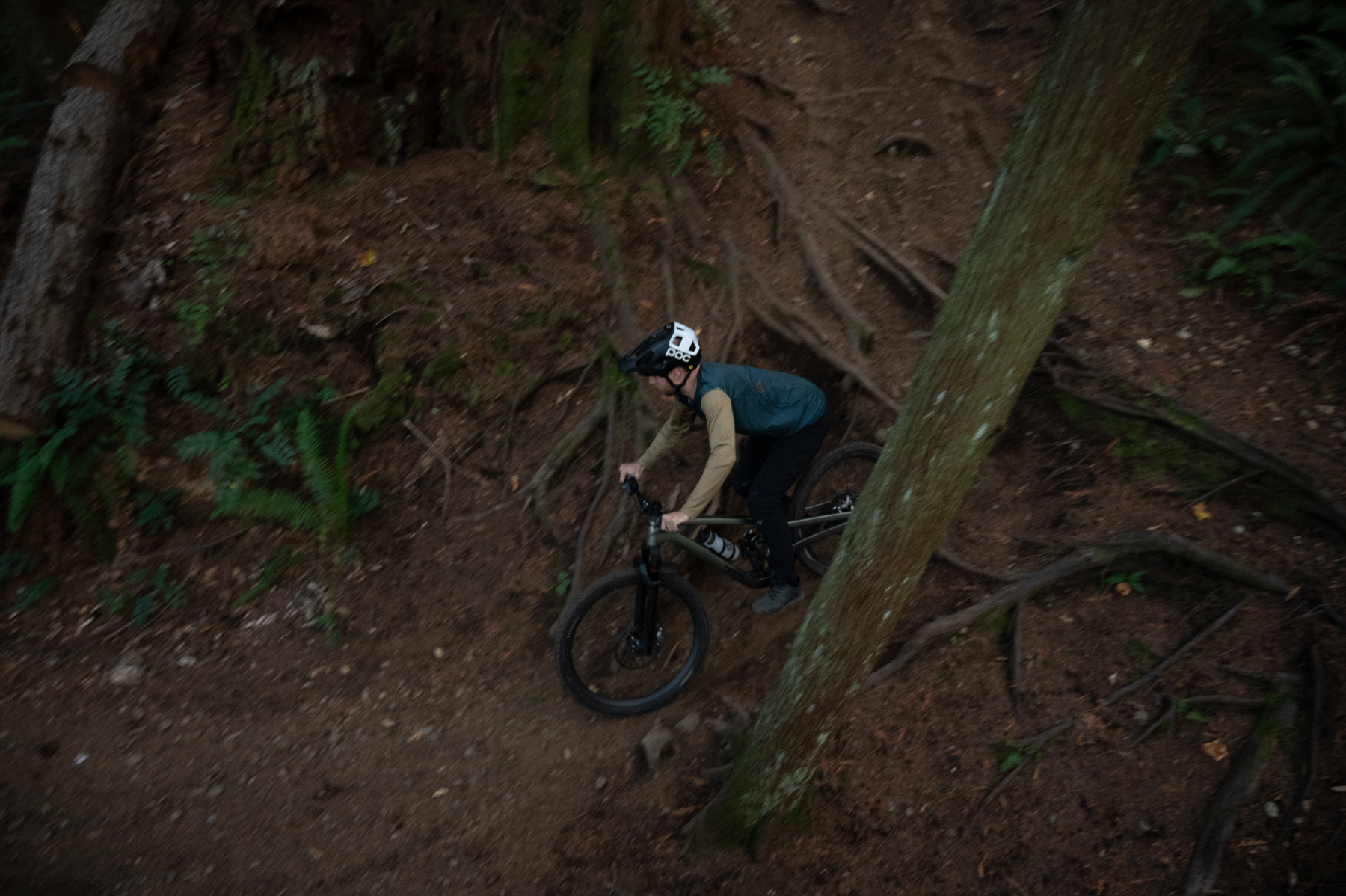
Chain Retention
And now for the elephant in the room. There’s been a lot of chatter across various corners of the internet about the Slash dropping chains left and right, and while I did drop the chain a few times over the course of my testing, it seems to be solvable, and ultimately a matter of chainguide setup. Here’s how it all went during my testing:
The Slash showed up as most review bikes do: mostly assembled, with the front wheel and handlebars removed in order to box up the whole thing. I started with the chainguide installed as it came from Trek; I dropped the chain off the underside of the chainring fairly quickly. The chainguide pulley looked like it was positioned pretty low, so I rotated it upward a bit, increasing the amount of chain wrap around the chainring, and everything was solid — no more dropped chains.
But then Trek sent a note saying they’d sent some early bikes out with the chainguide installed incorrectly, and things got a little more complicated. MRP, who make the lower guide, put together a document explaining how to set it up, with two main points: (1) there should be 7 mm of spacers between the ISCG tabs and the guide itself, to align the pulley with the chainring and (2) there should be a specified gap between the head of the chainguide mounting bolts and the end of the slot for them on the guide, setting the height for the pulley. Our bike showed up with 6 mm of spacers, and even after I’d previously clocked the guide upward, it was still quite a bit lower than MRP suggested, so I set everything up to their spec… and started dropping the chain a lot more regularly — this time off the inside of the pulley on the chainguide.
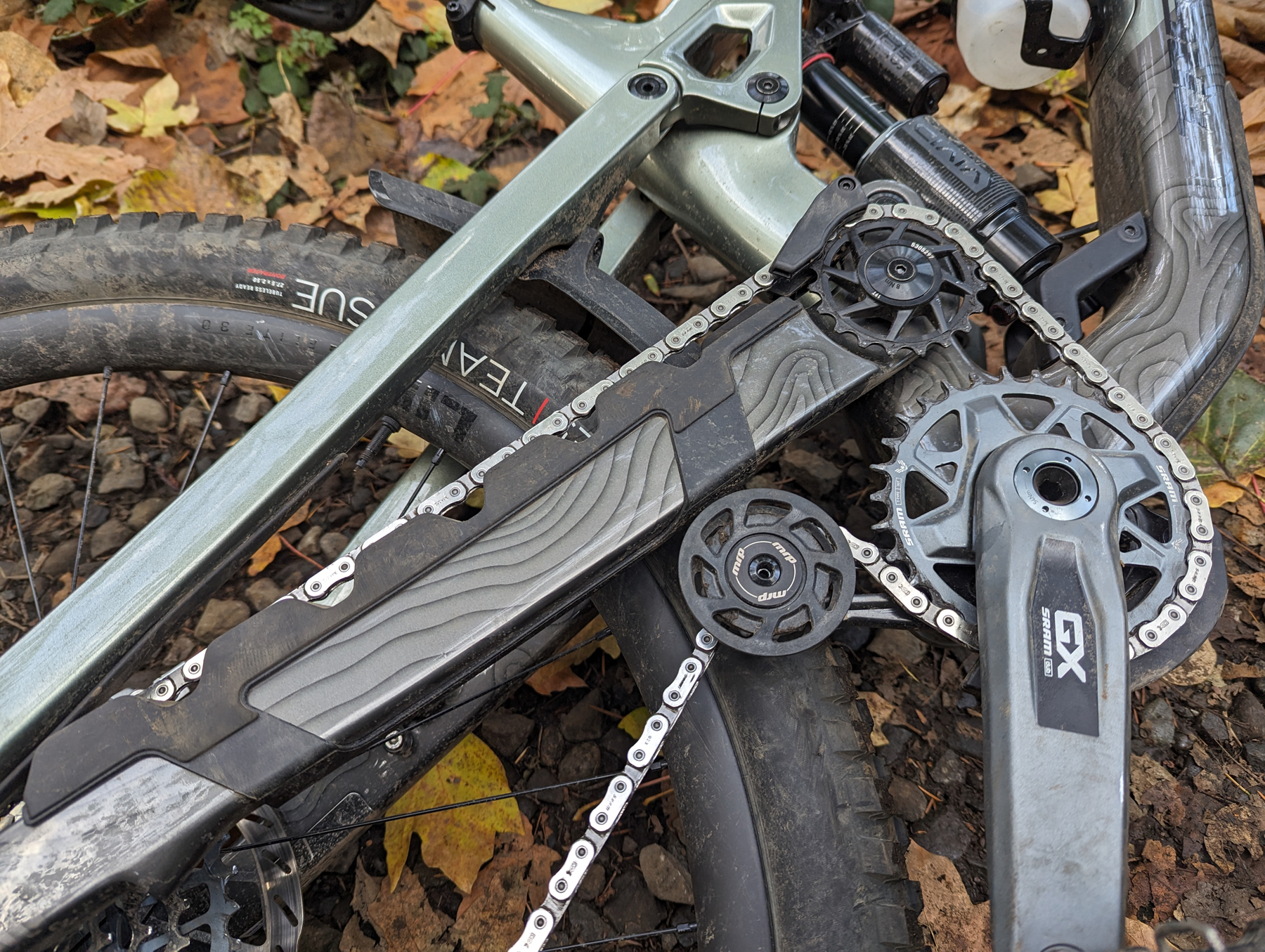
I followed up with Trek, and got word back that they’d been hasty in sending out the last set of recommendations — the 7 mm spacing was correct, but the pulley should be positioned lower than the MRP document called out, with 32 mm of spacing between the underside of the chainstay protector and the top of the pulley. And once I moved the guide back down to that setting, the chain stayed put — no more trouble again.
While that might seem counterintuitive, it makes some sense. Rotating the guide higher does increase the amount of chain wrap around the chainring (and therefore improves retention there) but also decreases the amount of chain growth along the lower run of the chain as the suspension cycles on the Slash — so that portion of the chain loses tension as the suspension compresses. Lowering the pulley a little bit increases tension on the lower portion of the chain as the suspension cycles, and for me, stopped the chain from coming off the chainguide pulley.
It’d certainly be nice if the chainguide setup wasn’t as sensitive, but there does seem to be a Goldilocks setting that works well. While I didn’t measure super precisely, the middle setting that I ran the guide in for the bulk of my testing was pretty close to the 32 mm spacing that Trek later recommended. Through that period, I had no issues with dropping the chain (even with the sub-optimal 6 mm spacing from the frame), nor did I have dropped chains after going to Trek’s stated 32 mm chainstay-to-roller gap and correcting the frame-to-guide spacing to 7 mm.
The build on our Slash 9.8 GX T-Type review bike is generally quite solid, though it’s not an especially great value for the money, at $8,000. The SRAM GX Transmission works well, and I’m a fan of the RockShox ZEB / Vivid suspension package; I didn’t miss the Buttercups (ZEB) or high-speed compression adjuster (Vivid) on the Select+ versions here too badly, as compared to their top-tier Ultimate counterparts. I was also glad to get the 200mm-drop Bontrager Line Elite dropper as compared to the 170mm-max RockShox Reverb AXS that comes on the 9.9 X0 build (I’m still very, very surprised that RockShox has yet to release a longer version). I didn’t get along with the shape of the Bontrager RSL one-piece bar / stem combo that comes on the higher-end 9.9 builds when I tested it on the Fuel EX earlier this year, and I also found the Bontrager Line Pro one that came on our Slash to be very, very stiff. I swapped it out for something more compliant and comfortable (a Spank Spike Vibrocore).
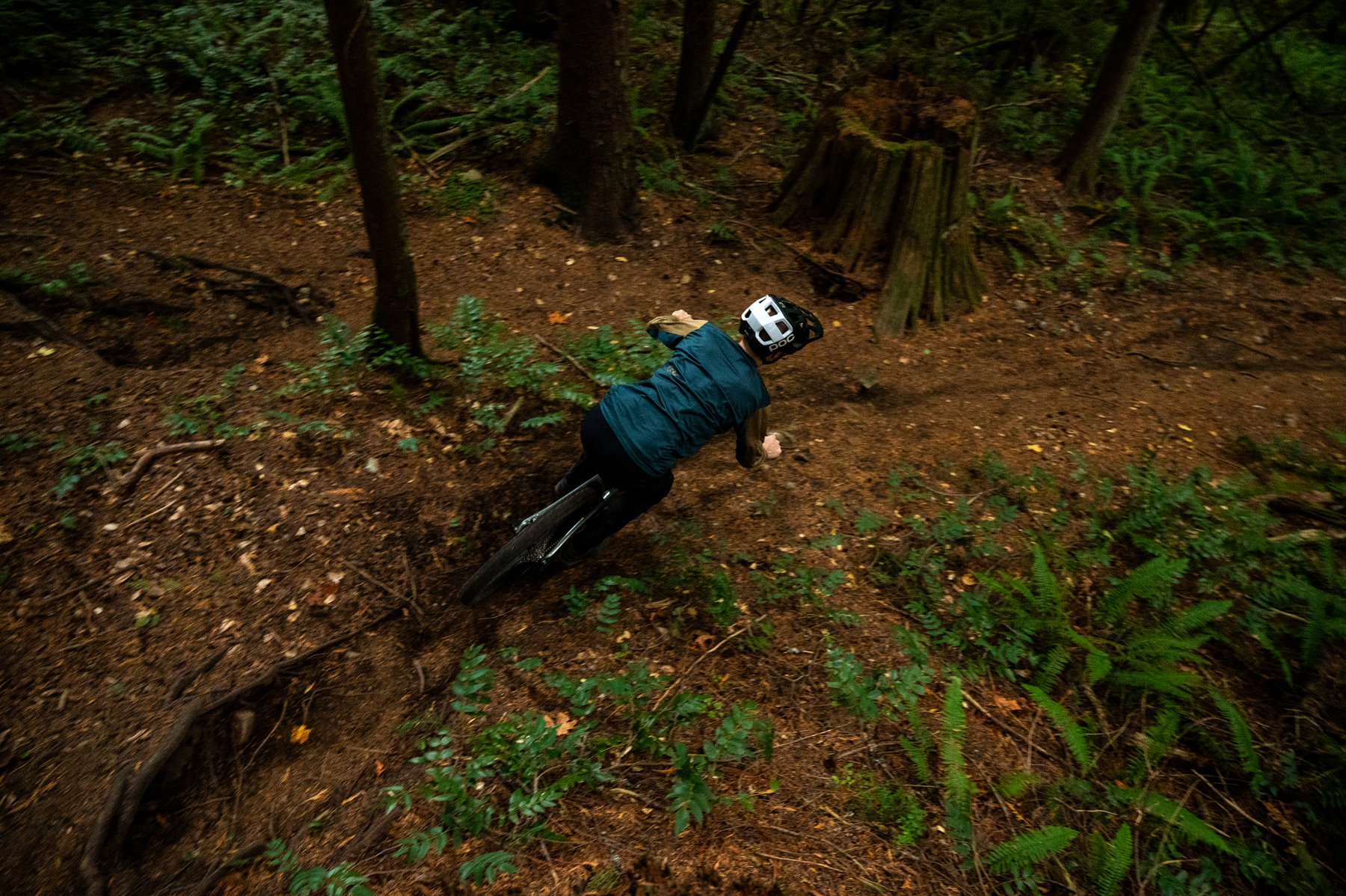
I also wasn’t a huge fan of the stock Bontrager SE6 front / SE5 rear tire combo — they work alright in drier conditions, but their relatively firm rubber doesn’t inspire much confidence on wet roots and rocks, and I also didn’t take long to put a couple of small holes in the casings. I swapped those out for beefier, grippier rubber (Continental Kryptotal DHs) for most of the test period, which felt better suited to the Slash’s capabilities.
While I was swapping wheels around, I also took the opportunity to put on a 220 mm front brake rotor. The SRAM Code Bronze Stealth brakes are a substantial improvement over the Code Rs that they effectively replace as the entry-level Code offering (I think mostly because they feature the Swinglink lever cam that the Code Rs lacked). But they’re still not the most powerful brakes out there, and the bigger front rotor helped on that front.
I would also love to see Trek offer the option for some full-29’’ builds on the Slash, at least in the larger sizes. Mullets are trendy and I absolutely get their appeal, especially for shorter folks on longer-travel bikes who could use some more tire-to-butt clearance. But as I described earlier, I personally clearly preferred the 29er setup on the Slash and it’d be nice to have the option without having to buy another wheel.
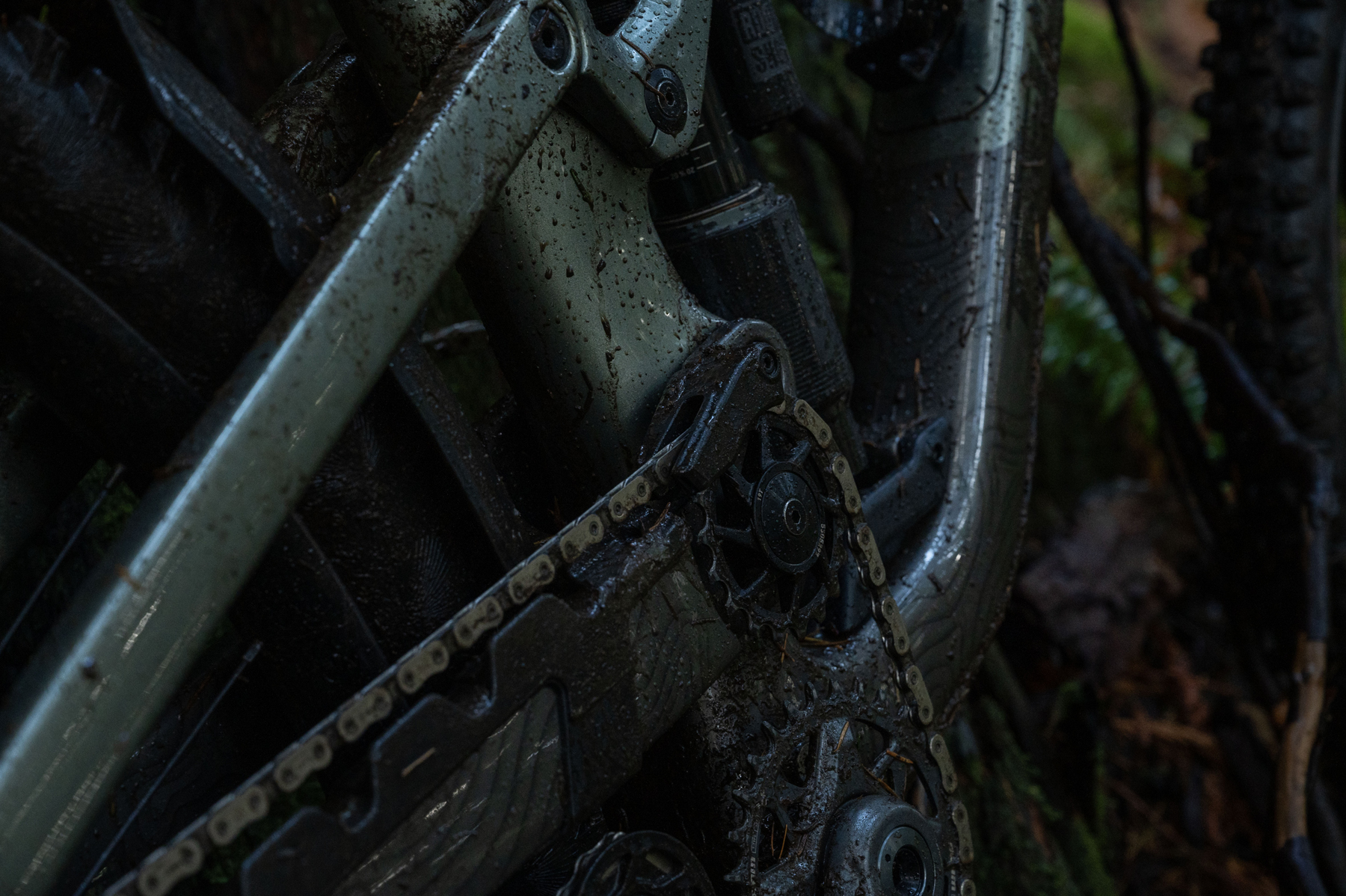
Who’s It For?
The Slash is a big, burly bike and is best suited to folks who are going to spend most of their time seeking out steep, technical descents — and try to ride them at pace. While it’s not the most engaging at lower speeds and on mellower trails, the Slash does pedal notably efficiently for what it is. It also does a very respectable job of not feeling completely out of its element if you’re taking things easier, and is generally very predictable and intuitive in its handling. The Slash would be a great Enduro race bike for folks whose preferences trend toward wanting a bike on the more stable, planted end of the spectrum, or those who just want a very confidence-inspiring bike for tackling big descents that still pedals to the top quite effectively, too.
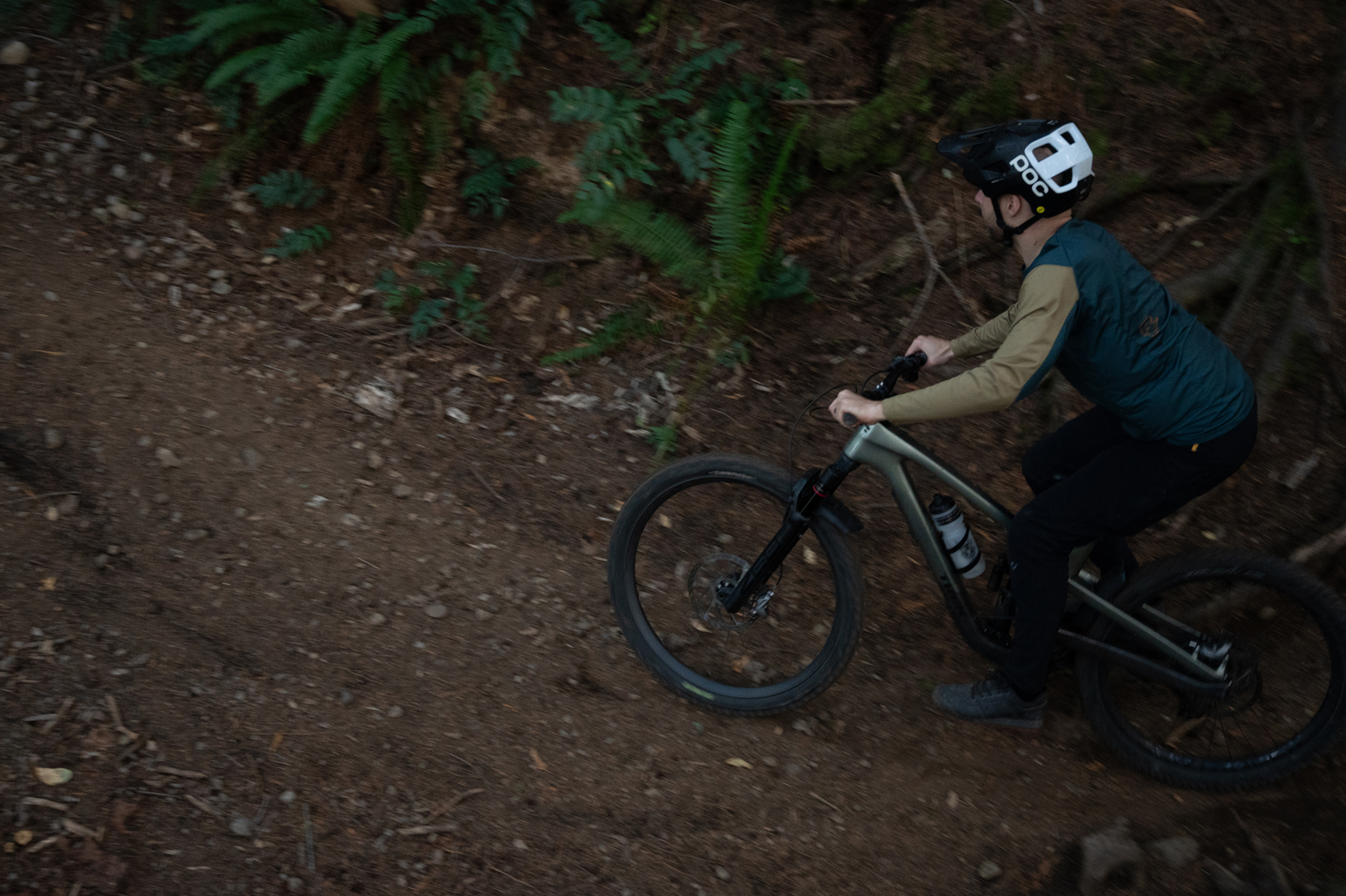
Bottom Line
The latest Trek Slash is undeniably a lot of bike — we’re talking about a 170mm-travel high-pivot platform, after all. It’s quite stable at speed, very composed and confidence-inspiring on steep, rough trails, and is less engaging on flatter, more mellow trails than most shorter-travel options out there.
But the Slash also pedals quite efficiently and does a surprisingly good job of feeling manageable in a relatively wide range of scenarios, beyond just wanting to charge on really burly descents. It would be nice to see a stock 29er option for the Slash, but as is it’s a great option for folks who want an especially stable, composed Enduro race bike, or a bike that’s particularly confidence-inspiring on very steep, rough descents while still pedaling relatively efficiently, and being a little more lively than most similarly planted and composed options, too.
Deep Dive Comparisons
BLISTER+ members and those who purchase our Digital Access Pass can check out our Deep Dive comparisons linked below. Get our Digital Access Pass to view all our Deep Dives and Flash Reviews, or become a BLISTER+ member today to get access to that and a LOT more, including the best worldwide Outdoor Injury Insurance, exclusive deals and discounts on skis, personalized gear recommendations from us, and much more.
Check out our Deep D ive comparisons of the Trek Slash to see how it compares to the Contra MC, Cannondale Jekyll, Norco Range, Forbidden Dreadnought, Canfield One.2 Super Enduro, Yeti SB160, Pivot Firebird, Santa Cruz Megatower, and Propain Tyee.
10 comments on “2024 Trek Slash”
Trek makes some great products and I’m sure they have done a ton of testing, but having owned an idler bike (cannondale jekyll), I will never own a 2 idler bike.
Nice and thorough review. I was looking forward to your comparison to the Nomad v6, any quick thoughts?
Pretty different. The Slash actually pedals a little more efficiently but is more stable at speed and less nimble / easy to throw around. And especially with the Slash in the stock mullet configuration they prefer quite different body positioning, with the Nomad favoring a much more centered, upright stance.
At a quick glance the most strikingly similar design to the Slash seems to be the Kavenz VHP 16 which was an interesting bike reviewed earlier this year. As someone interested in the Kavenz because of your exposure I’d love to know how they compare. Otherwise, another great review!
Good call, though they don’t remind me of each other that much.
The Kavenz is more lively, nimble, and generally playful feeling; the Slash is more stable, planted, and feels more focused on going fast / outright composure at speed. The Slash feels fairly manageable in tight spots and on mellower trails for what it is, but the Kavenz is quite a bit more versatile overall.
What if you could try the Kavenz with the newer longer chainstays? Seems like a lot of straight line stability and nimbleness comes from the chainstays.
I’d want to try it before I say anything definitive, but the Kavenz with the new adjustable length chainstays (and tweaked sizing — I’d probably go up to an XL on it now, especially with longer chainstays) seems really intriguing.
Exhaustive. Can you pls compare the Slash to HD6?
We’ve been trying to get on an HD6 but haven’t been able to make it happen yet, unfortunately.
Curious to know what your suspension settings were?
Leave a Comment Cancel reply
- MAGAZINE OFFERS
- BIKE INSURANCE
- Best Products
- Maintenance
- Accessories
- Long-Term Reviews
- First Look Friday
- Bike of the Week
- Tech Features
- Routes and Rides
- Bike Galleries
- BikeRadar Bargains
- Buyer's Guides
- Fitness & Training
- Sizing & Fit
- Mountain Biking UK
- Cycling Plus
- BikeRadar Podcast
Trek Slash 8 Gen 6 review | Enduro Bike of the Year contender
Trek’s high-pivot, big-travel Slash 8 boasts good value and promises a lot on the trail
Laurence Crossman-Emms / Our Media
Robin Weaver
Composed feel at speed; climbs really well; great geometry; shock tunes helps it feel lively and playful; solid spec for the money
Tyres struggle in mud and aren’t tough enough; fork requires careful tuning to compensate for performance limitations
Trek has historically done well in our Enduro Bike of the Year category, with the Slash taking top honours back in 2021.
The latest Slash Gen 6 frames feature a high-pivot suspension design to deliver the 170mm of rear-wheel travel, come with a mixed-wheel setup as standard and offer up plenty of suspension and geometry adjustment.
On top of that, the new Slash also gets the standard lower, longer and slacker treatment in a bid to make this a genuine World enduro race winner.
The Slash 8 is the cheapest of the seven-bike Gen 6 line-up, uses an aluminium frame and comes with some solid parts from the likes of Shimano and Fox.
Although it's the cheapest of the eight bikes in my Enduro Bike of the Year test, it really packs a punch on the trail, with a ride that stands out for all the right reasons.
It’s sprightlier than expected and more playful too, but get stuck into the really rough stuff and it’s impressive just how well the rear end smooths out the trail.
Push too hard, though, and some of the spec choices start to hold this otherwise impressive rig back.
Trek Slash 8 Gen 6 frame and suspension details

The Slash 8 Gen 6 is made from Trek’s Alpha Platinum Aluminium, sports a plethora of rubberised driveside frame protection to help quieten chain slap and has under-belly guards to fend off rock strikes.
High-pivot designs are nothing new to Trek (the Diesel downhill bike was released more than 20 years ago), though they tend not to feature on bikes that need to be pedalled a lot.
That’s all changed with the latest Slash Gen 6 frame, which – you guessed it – now sports a high main pivot.
The bike continues to use Trek’s ABP (Active Braking Pivot) suspension layout, which sees the chain and seatstay pivot concentric to the rear wheel axle. That equates to a single pivot with a linkage-actuated rear shock.
The high main pivot creates a rearward axle path, designed to deal better with momentum killing square-edge hits.

In total, Trek says this moves a maximum of 18mm back from its starting point (growing the effective chainstay measurement) at around 135mm into the 170mm of rear-wheel travel before continuing to arc upwards and forwards for the remainder.
With 30 per cent sag, it’s estimated that the effective chainstay length will have increased by 11mm, sitting at around 440mm.
A massive upper idler helps to mitigate pedal kickback – a result of the rearward axle movement.
The lower idler cog is designed to take tension off the rear derailleur. This is not only to help it continue to shift properly and more efficiently, but to increase suspension sensitivity (because the lower section of the chain isn’t trying to extend the derailleur against its clutch mechanism).

Sizes small through to large need a standard 126-link chain, while the XL requires an extra-long 128-link chain.
To ensure the Slash Gen 6 can work with a coil-sprung shock , there’s a flip chip in the lower shock mount that enables you to increase the level of progression across the 170mm of travel from 20 to 25 per cent.
There’s also some integrated down tube storage for stashing essentials out of the way.
Trek Slash 8 Gen 6 geometry details

Trek offers the Slash Gen 6 in small, medium, medium/large, large and extra-large sizes.
The size small comes with 27.5in wheel front and back, while all other sizes use a 29in front and 27.5in rear wheel as standard.
There’s the option to switch to a larger rear wheel, although you’ll need to purchase a different lower shock mount to do so (£29.99).
Likewise, if you’re keen on altering the head angle, Trek sells aftermarket angled headset cups (plus or minus 1 degree) for £27.49.
I measured the Slash 8 to sport a slack head angle of 63.4 degrees, with a front centre of 790mm.
The seat tube angle is steep at 77.7 degrees, and the effective top tube quite compact for a size medium at 578mm.
Reach isn’t the longest at 448mm, but thanks to the compact seat tube lengths (400mm on the medium) across the size range, many riders will be able to size up if they’re looking for a roomier ride.
On paper, the Slash’s chainstay length looks really short at 429mm, but remember, as the bike drops through its travel, the rear axle moves backwards, effectively increasing this figure.
Trek Slash 8 Gen 6 specification

Trek has been smart with where it has spent the budget on the Slash 8.
Shimano XT gearing is great to see on this level of bike, and it’s no issue that this has been made possible in part thanks to the use of the lower-spec Deore crankset.
The brakes are also from Shimano, in the shape of Deore M6100 levers and four-piston M6120 calipers.
Taking care of the 170mm of travel at the front is a Fox 36 Rhythm fork, which uses the brand’s cheapest and most simplistic GRIP damper with limited adjustment compared to the pricier GRIP2 equivalent found on more expensive mountain bike forks .

This is matched to a Float X Performance rear shock.
In-house parts brand, Bontrager takes care of just about everything else, including the bar and stem. Unlike the pricier Slash 9.9 X0 AXS T-Type , it doesn’t use Trek's one-piece bar and stem, which is a plus in my eyes.
Bontrager also provides the wheels and XR5 Team Issue tyres.
All in, the medium Slash 8 Gen 6 on test weighed 17.01kg without pedals.
Trek Slash 8 Gen 6 ride impressions

I tested the Slash 8 on a wide variety of trails dotted around the Forest of Dean, South Wales and BikePark Wales.
These spanned from flowy jump lines through to hand-cut, steep, technical, natural descents, along with plenty of high-speed, rough-and-ready bike park tracks thrown in for good measure.
This enabled me to develop a thorough understanding of what the Slash 8 is good at and where it struggles.
Trek Slash 8 Gen 6 setup

Setup was quite straightforward, settling on 30 per cent sag for my 68kg weight with 147psi in the spring and the rebound damping left fully open. However, the fork became more of a puzzle as time progressed.
Initially, I settled on 71psi in the fork’s air spring, with only a couple of clicks of rebound damping wound on (from fully open). This offered masses of comfort and a decent level of traction.
As time went by and I felt more comfortable on the Trek, I had to increase the spring pressure and rebound damping to try to raise the level of support on offer.
I finished with 75.5psi in the air spring and no volume spacers.
Trek Slash 8 Gen 6 climbing performance

The Trek’s seated position is upright and comfortable, thanks to the steep seat tube angle.
It’s not particularly stretched out, though, due to the relatively short effective top tube and stumpy 35mm stem.
I wasn’t ever uncomfortable and didn’t feel cramped, but I noticed that compact position occasionally when scaling steeper, technical inclines. At 172cm, I think I could comfortably go up a frame size and negate these issues, though.
However, that’s not the headline here. What takes all the attention is how well this long-travel big hitter pedals.

Get cranking and the rear shock stays spookily still while you tick off the vertical metres. It helps that the tyres roll pretty quickly, too, limiting drag and injecting a bit of get up and go into proceedings.
With so little movement from the back end, you can leave the shock’s low-speed compression lever well alone because you don’t need it.
On every climb I tried, the Slash 8 felt the sprightliest and most energetic when pointed uphill, which is quite surprising considering its weight. It’s only when faced with soft mud that progress is stifled, due to the rear tyre lacking enough bite to generate grip and spinning up easier than others.
Trek Slash 8 Gen 6 descending performance

That energetic feel translates instantly to the trail when descending, too.
Trek has nailed the rear shock tune with this bike, producing a seriously capable bump gulper that helps generate traction when needed, but never sucks the fun out of even the tamest of tracks.
The fast-rolling tyres play a part in all of this, but the comfortable, well-balanced suspension helps the Slash remain playful, agile and, most importantly, fun when skimming through undulations and gapping rollers.
Speed seems to come easily, even when boosting in and out of slow-paced turns. Pick-up from the rear hub is quick and dumping gears quickly thanks to the precise XT shifter and derailleur is rapid when you find yourself wanting to inject even more speed to proceedings.
Square-edge what?

Pummel into faster, rougher sections of trail and the back end of the Slash really starts to shine.
The high-pivot design does a great job of scalping the peaks of the ugliest square-edge hits, helping you to stay online and composed at speed.
It’s this sensation that builds confidence and encourages you to ride faster. However, this is when you’ll start to reach the limits of the fork and tyres.

The Fox 36 Rhythm fork, with its GRIP damper, is one of the comfiest suspension forks on the market. But push it hard and you’ll be left puzzling over how to best balance that comfort with support.
My initial starting point delivered a beautifully supple ride, but lacked support when riding faster tracks, causing the front end to drop away with higher-load compressions and landings, and upsetting overall balance.
Upping the spring pressure and adding volume spacers helps here, but reduces overall comfort. The basic compression dial doesn’t exactly enable fine-tuning.
To unlock the full potential of the Slash 8, you’d be best to get the fork professionally tuned (roughly £120 for a service, plus £50 for custom tuning) so it can better handle being ridden hard without compromising that impressive comfort too much.

Similarly, I found myself incrementally adding pressure to the tyres , too, because they’re not as supportive or as tough as the best mountain bike tyres . This was largely because I found myself burping the rear tyre all too easily.
Thanks to the supple suspension, I didn’t find this to impact comfort too much, but you can feel the effects in terms of traction, especially when tackling anything remotely wet.
Swapping to your preferred tyre combo from the get-go should be high on your to-do list. You might want to ditch the chunky, wide-diameter grips while you’re at it.
Mega momentum

Despite those niggles, I never failed to have fun riding the Slash 8 and was always impressed by how well it could maintain speed.
On rough, high-speed tracks littered with rocks ready to sap your speed, the Trek always managed to retain incredible pace.
The back end beavers away tirelessly to isolate you from the worst impacts, enabling you to remain centred on the bike and focused on your line.

When speed started to dwindle, I had sufficient support, enabling me to pump undulations and compression in a bid to boost speed. However, I’d argue the Slash isn’t as direct and punchy in that sense as some of its rivals.
The geometry isn’t as lengthy or as raked out as some, but it still feels a confident bike to ride, even more so if you swap to grippier tyres.
Through the turns, the low 340mm bottom bracket helps to keep things suitably stable, while the suspension tracks the terrain almost effortlessly.
How does the Trek Slash 8 Gen 6 compare?

As the second most expensive bike within the Enduro Bike of the Year test, I’m going to compare the Slash 8 to the Transition Spire Alloy NX.
The Spire costs £50 more and comes with the same rear shock and a Marzocchi Z1 fork with the same GRIP damper.
But while the Slash features pricier Shimano XT gearing, the Spire has SRAM’s NX Eagle transmission. This proved to be clunkier and more problematic to keep running smoothly after months of riding in grim conditions.
The Spire suffers from the same fork issues as the Slash – impressive comfort but lacking in high-speed support when you really start pushing the bike.
Both bikes climb well, but the Slash feels a little punchier when grinding its way uphill.
On the descents, while the Spire offers a smooth ride, it can’t quite compete with the supple high-pivot bump-eating back end of the Slash.
The Slash is, overall, a comfier ride, too, with more feedback coming through the front end of the Spire when battering through repeated hits.
Enduro Bike of the Year 2024 | How we tested
The expectations resting on the shoulders of any enduro bike couldn’t be heavier. Creating a bike capable of tackling just about any trail revolves around smart choices and compromise.
In the simplest terms, enduro riding and racing is all about winching your way up to the top of a hill or mountain, then tackling an often-challenging descent.
These bikes are designed to excel at downhills.
How a bike handles the climb isn’t the be-all and end-all when it comes to overall performance, but pedalling efficiency and seated geometry still need to be factored in.
When it comes to geometry, we’re looking for stability and composure, but without dulling playfulness and agility.
A balanced suspension system creates a stable ride, but engineers also need to factor in the right amount of support for the rider to push against when pumping the terrain, and enough sensitivity to ensure the tyres can maximise traction on just about any surface.
Over a three-month period, all the bikes in this category were ridden back-to-back, as well as in different orders, in a bid to eke out every difference between them.
The trails in question varied from steep, natural downhill tracks and forest singletrack through to the high speeds and hefty impacts of BikePark Wales.
Our Enduro Bike of the Year contenders
- Santa Cruz Megatower C R
- Transition Spire Alloy NX
- Ibis HD6 XT
- Kona Process X CR
- Marin Alpine Trail XR
- YT Capra 29 Core 4
- Cube Stereo One77 C:68X TM 29
- Trek Slash 8 Gen 6
Trek Slash 8 Gen 6 bottom line

The Trek is a seriously smooth operator and really impressive for the cash.
Supple, well-balanced suspension and some really solid gear choices make it a formidable bike on the hills.
The fact that it has so much travel and a high-pivot, but climbs like a much lighter, shorter-travel machine is a massive bonus.
Push hard and the fork can’t keep up with the shock – and lacks the same level of composure at really high speeds. Meanwhile, the tyres are best suited to trail-centre pootling rather than full-on enduro riding and racing.
Swap the tyres and get the fork tuned to optimise performance and the Slash 8 Gen 6 will be an absolute rocket ship on the toughest of trails.
Share this article

Technical editor-in-chief
You may also like
Bikeradar newsfeed, vitus sommet 297 amp review, yt capra 29 core 4 review, merida one-sixty 6000 review, giant reign 1 review.

- Terms & Conditions
- Subscribe to our magazines
- Manage preferences

IMAGES
VIDEO